AGILE TRANSFORMATION Snags Additional Awards from BookAuthority; Trailer Updated
17 October 2019
Follow @scottgraffius
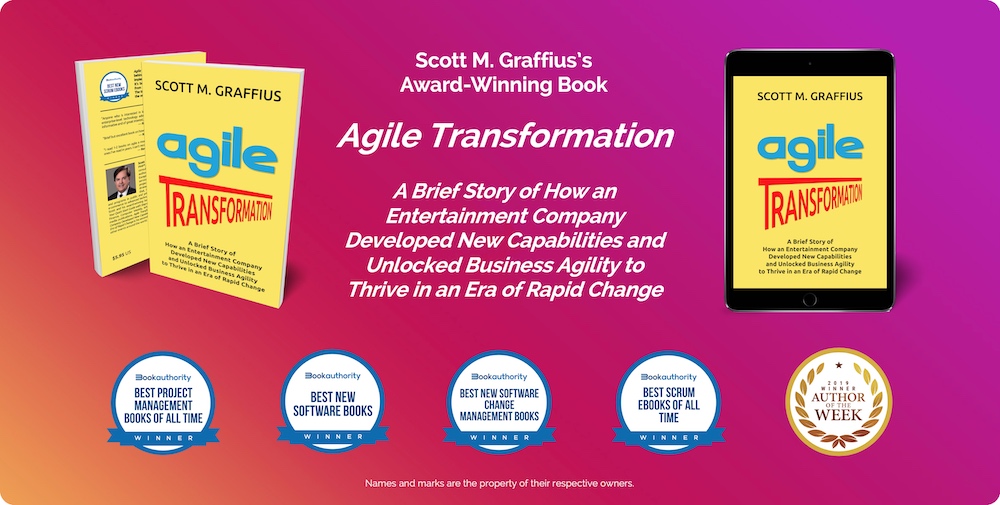
Soon after Agile Transformation: A Brief Story of How an Entertainment Company Developed New Capabilities and Unlocked Business Agility to Thrive in an Era of Rapid Change was released earlier this year, BookAuthority named the ebook/Kindle format of the publication a winner in multiple categories, including Best Scrum Ebooks of All Time. Agile Transformation is also available in print, and BookAuthority recently honored the paperback as a winner in multiple categories, including Best Project Management Books of All Time. Thank you to BookAuthority for the recognition! The short (30-second) trailer for the book was updated to highlight the two awards listed above. Details and the refreshed trailer are available here: https://www.facebook.com/AgileTransformationBook/videos/450537145587506/. You’re invited to check them out.


About Author Scott M. Graffius

Scott M. Graffius, CSP-SM, CSP-PO, CSM, CSPO, PMP, ITIL, LSSGB is a project management expert, consultant, speaker, and author. He is a Principal Consultant and the CEO of Exceptional PPM and PMO Solutions™, a professional services firm, where he helps clients strengthen their project management capabilities and realize their strategic objectives and business initiatives. Before that, he ran and supervised the delivery of projects and programs in public and private companies with businesses ranging from e-commerce to advanced technology, manufacturing, entertainment, and more. Scott and his award-winning book on agile project management, Agile Scrum: Your Quick Start Guide with Step-by-Step Instructions, have been featured in Yahoo Finance, the Boston Herald, Learning Solutions, Informa, Innovation Management, and additional media publications. His second title, Agile Transformation: A Brief Story of How an Entertainment Company Developed New Capabilities and Unlocked Business Agility to Thrive in an Era of Rapid Change, was published in April 2019. BookAuthority named it one of the best new books on Scrum. Scott regularly speaks at conferences and other events around the world.
His full bio is available here.
Connect with Scott on:
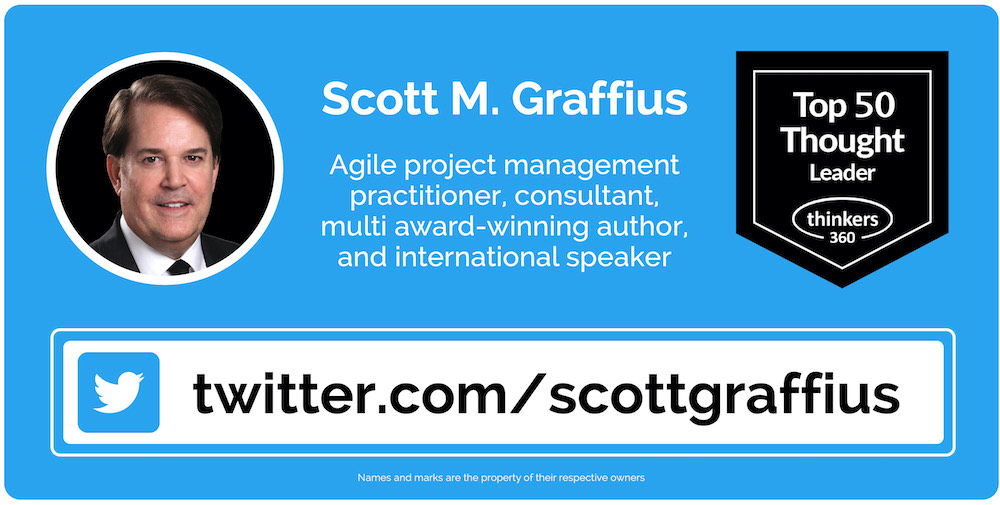

About Agile Scrum: Your Quick Start Guide with Step-by-Step Instructions
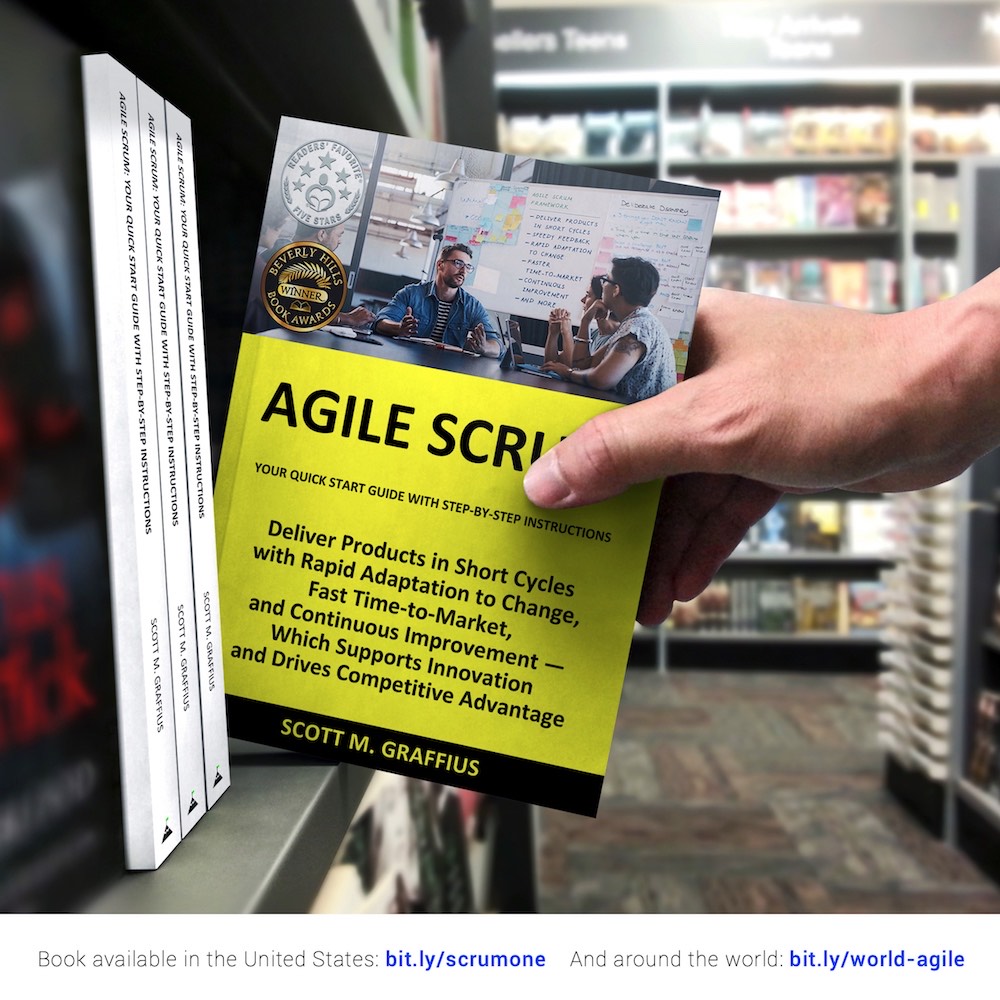
Shifting customer needs are common in today's marketplace. Businesses must be adaptive and responsive to change while delivering an exceptional customer experience to be competitive.
There are a variety of frameworks supporting the development of products and services, and most approaches fall into one of two broad categories: traditional or agile. Traditional practices such as waterfall engage sequential development, while agile involves iterative and incremental deliverables. Organizations are increasingly embracing agile to manage projects, and best meet their business needs of rapid response to change, fast delivery speed, and more.
With clear and easy to follow step-by-step instructions, Scott M. Graffius's award-winning Agile Scrum: Your Quick Start Guide with Step-by-Step Instructions helps the reader:
Hailed by Literary Titan as “the book highlights the versatility of Scrum beautifully.”
Winner of 17 first place awards.
Agile Scrum: Your Quick Start Guide with Step-by-Step Instructions is available in paperback and ebook/Kindle in the United States and around the world. Some links by country follow.

About Agile Transformation: A Brief Story of How an Entertainment Company Developed New Capabilities and Unlocked Business Agility to Thrive in an Era of Rapid Change
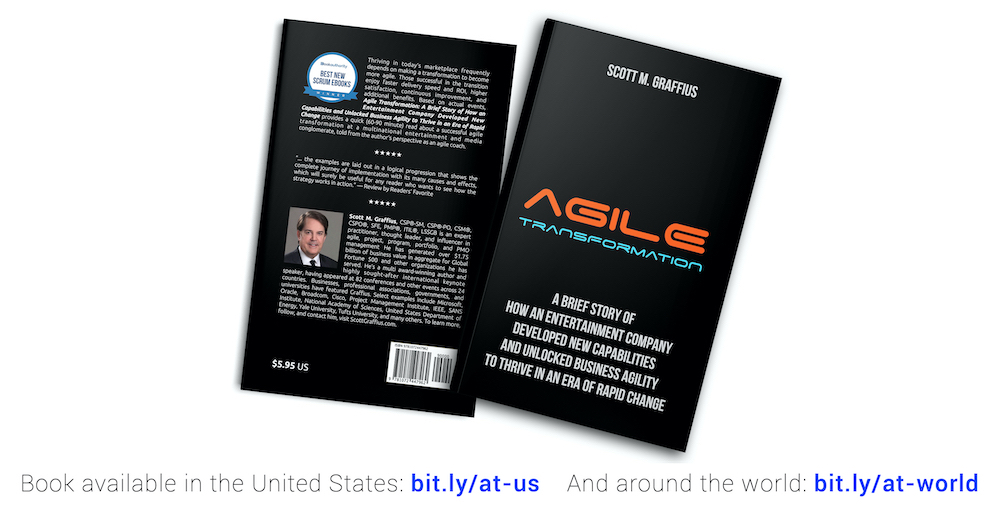
Thriving in today's marketplace frequently depends on making a transformation to become more agile. Those successful in the transition enjoy faster delivery speed and ROI, higher satisfaction, continuous improvement, and additional benefits.
Based on actual events, Agile Transformation: A Brief Story of How an Entertainment Company Developed New Capabilities and Unlocked Business Agility to Thrive in an Era of Rapid Change provides a quick (60-90 minute) read about a successful agile transformation at a multinational entertainment and media company, told from the author's perspective as an agile coach.
The award-winning book by Scott M. Graffius is available in paperback and ebook/Kindle in the United States and around the world. Some links by country follow.

About BookAuthority
BookAuthority curates the books recommended by the world's most successful CEOs, business leaders, and domain experts such as Elon Musk, Warren Buffett, Sheryl Sandberg, and David Allen. Only the very best books are featured on BookAuthority. To keep BookAuthority's site objective and unbiased, ratings are calculated purely based on data. BookAuthority uses a proprietary technology to identify and rate the best nonfiction books, using dozens of different signals, including public mentions, recommendations, ratings, sentiment, popularity and sales history. BookAuthority does not accept requests to feature books, nor does BookAuthority conduct business with publishers or authors. BookAuthority has been featured on CNN, Forbes and Inc. The preceding information is based on content from BookAuthority.org.

© Copyright 2019 Scott M. Graffius. All rights reserved. This material may not be published, broadcast, rewritten or redistributed without the express written permission of Scott M. Graffius.


Soon after Agile Transformation: A Brief Story of How an Entertainment Company Developed New Capabilities and Unlocked Business Agility to Thrive in an Era of Rapid Change was released earlier this year, BookAuthority named the ebook/Kindle format of the publication a winner in multiple categories, including Best Scrum Ebooks of All Time. Agile Transformation is also available in print, and BookAuthority recently honored the paperback as a winner in multiple categories, including Best Project Management Books of All Time. Thank you to BookAuthority for the recognition! The short (30-second) trailer for the book was updated to highlight the two awards listed above. Details and the refreshed trailer are available here: https://www.facebook.com/AgileTransformationBook/videos/450537145587506/. You’re invited to check them out.

About Author Scott M. Graffius

Scott M. Graffius, CSP-SM, CSP-PO, CSM, CSPO, PMP, ITIL, LSSGB is a project management expert, consultant, speaker, and author. He is a Principal Consultant and the CEO of Exceptional PPM and PMO Solutions™, a professional services firm, where he helps clients strengthen their project management capabilities and realize their strategic objectives and business initiatives. Before that, he ran and supervised the delivery of projects and programs in public and private companies with businesses ranging from e-commerce to advanced technology, manufacturing, entertainment, and more. Scott and his award-winning book on agile project management, Agile Scrum: Your Quick Start Guide with Step-by-Step Instructions, have been featured in Yahoo Finance, the Boston Herald, Learning Solutions, Informa, Innovation Management, and additional media publications. His second title, Agile Transformation: A Brief Story of How an Entertainment Company Developed New Capabilities and Unlocked Business Agility to Thrive in an Era of Rapid Change, was published in April 2019. BookAuthority named it one of the best new books on Scrum. Scott regularly speaks at conferences and other events around the world.
His full bio is available here.
Connect with Scott on:


About Agile Scrum: Your Quick Start Guide with Step-by-Step Instructions

Shifting customer needs are common in today's marketplace. Businesses must be adaptive and responsive to change while delivering an exceptional customer experience to be competitive.
There are a variety of frameworks supporting the development of products and services, and most approaches fall into one of two broad categories: traditional or agile. Traditional practices such as waterfall engage sequential development, while agile involves iterative and incremental deliverables. Organizations are increasingly embracing agile to manage projects, and best meet their business needs of rapid response to change, fast delivery speed, and more.
With clear and easy to follow step-by-step instructions, Scott M. Graffius's award-winning Agile Scrum: Your Quick Start Guide with Step-by-Step Instructions helps the reader:
- Implement and use the most popular agile framework―Scrum;
- Deliver products in short cycles with rapid adaptation to change, fast time-to-market, and continuous improvement; and
- Support innovation and drive competitive advantage.
Hailed by Literary Titan as “the book highlights the versatility of Scrum beautifully.”
Winner of 17 first place awards.
Agile Scrum: Your Quick Start Guide with Step-by-Step Instructions is available in paperback and ebook/Kindle in the United States and around the world. Some links by country follow.
- 🇧🇷 Brazil
- 🇨🇦 Canada
- 🇨🇿 Czech Republic
- 🇩🇰 Denmark
- 🇫🇮 Finland
- 🇫🇷 France
- 🇩🇪 Germany
- 🇬🇷 Greece
- 🇭🇺 Hungary
- 🇮🇳 India
- 🇮🇪 Ireland
- 🇮🇱 Israel
- 🇮🇹 Italy
- 🇯🇵 Japan
- 🇱🇺 Luxembourg
- 🇲🇽 Mexico
- 🇳🇱 Netherlands
- 🇳🇿 New Zealand
- 🇳🇴 Norway
- 🇪🇸 Spain
- 🇸🇪 Sweden
- 🇨🇭 Switzerland
- 🇦🇪 UAE
- 🇬🇧 United Kingdom
- 🇺🇸 United States

About Agile Transformation: A Brief Story of How an Entertainment Company Developed New Capabilities and Unlocked Business Agility to Thrive in an Era of Rapid Change

Thriving in today's marketplace frequently depends on making a transformation to become more agile. Those successful in the transition enjoy faster delivery speed and ROI, higher satisfaction, continuous improvement, and additional benefits.
Based on actual events, Agile Transformation: A Brief Story of How an Entertainment Company Developed New Capabilities and Unlocked Business Agility to Thrive in an Era of Rapid Change provides a quick (60-90 minute) read about a successful agile transformation at a multinational entertainment and media company, told from the author's perspective as an agile coach.
The award-winning book by Scott M. Graffius is available in paperback and ebook/Kindle in the United States and around the world. Some links by country follow.
- 🇦🇺 Australia
- 🇦🇹 Austria
- 🇧🇷 Brazil
- 🇨🇦 Canada
- 🇨🇿 Czech Republic
- 🇩🇰 Denmark
- 🇫🇮 Finland
- 🇫🇷 France
- 🇩🇪 Germany
- 🇬🇷 Greece
- 🇮🇳 India
- 🇮🇪 Ireland
- 🇯🇵 Japan
- 🇱🇺 Luxembourg
- 🇲🇽 Mexico
- 🇳🇱 Netherlands
- 🇳🇿 New Zealand
- 🇪🇸 Spain
- 🇸🇪 Sweden
- 🇨🇭 Switzerland
- 🇦🇪 United Arab Emirates
- 🇬🇧 United Kingdom
- 🇺🇸 United States

About BookAuthority
BookAuthority curates the books recommended by the world's most successful CEOs, business leaders, and domain experts such as Elon Musk, Warren Buffett, Sheryl Sandberg, and David Allen. Only the very best books are featured on BookAuthority. To keep BookAuthority's site objective and unbiased, ratings are calculated purely based on data. BookAuthority uses a proprietary technology to identify and rate the best nonfiction books, using dozens of different signals, including public mentions, recommendations, ratings, sentiment, popularity and sales history. BookAuthority does not accept requests to feature books, nor does BookAuthority conduct business with publishers or authors. BookAuthority has been featured on CNN, Forbes and Inc. The preceding information is based on content from BookAuthority.org.

© Copyright 2019 Scott M. Graffius. All rights reserved. This material may not be published, broadcast, rewritten or redistributed without the express written permission of Scott M. Graffius.

The Spanish Version of the 'Phases of Team Development' -- 'Fases del Desarrollo del Equipo' -- Now Available
19 October 2021
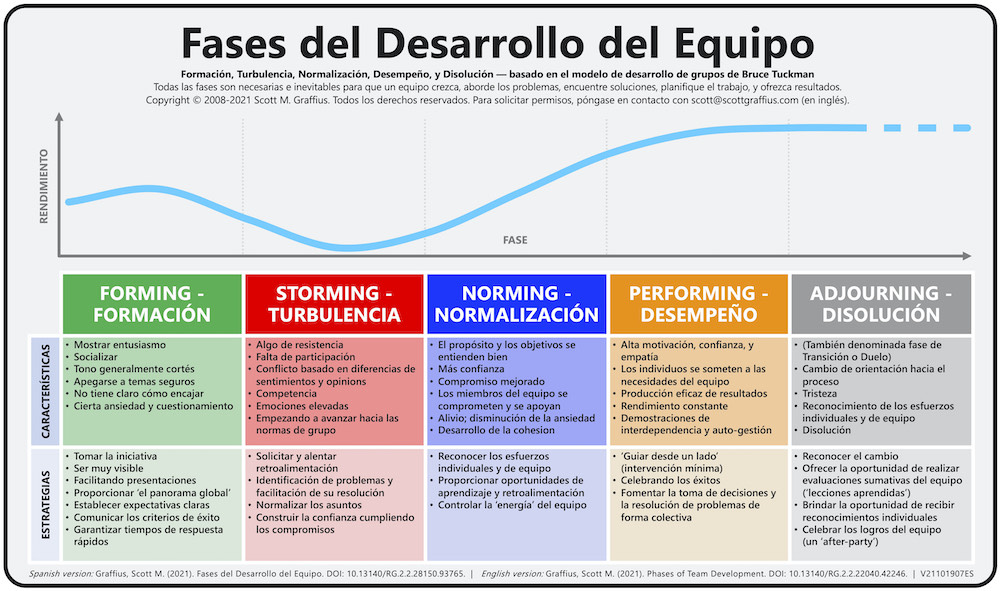
For permission requests and high resolution images, see below.
Phases of Team Development
Teams go through phases of development, and Dr. Bruce Tuckman established a popular and durable framework on the subject. According to Dr. Tuckman, all phases—Forming, Storming, Norming, Performing, and Adjourning—are necessary for teams to grow, tackle problems, find solutions, plan work, and deliver results.
Agile project management thought leader, influencer, and author Scott M. Graffius developed a related custom illustration, Phases of Team Development. It highlights the performance level, characteristics, and proven strategies for each of the phases. Project Managers, Scrum Masters, Agile Coaches, DevOps Leads, and other professionals can apply the information to help handle challenges or issues experienced by teams. By doing so, they’ll advance the teams' happiness and productivity, as well as the teams' (and their own) success. Graffius updates the content periodically.
Graffius translated his 'Phases of Team Development' intellectual property into Spanish: 'Fases del Desarrollo del Equipo' — Formación (Forming), Turbulencia (Storming), Normalización (Norming), Desempeño (Performing), and Disolución (Adjourning).
Sometimes, different words are used for the phases. For example, 'Storming' is translated as 'Turbulencia' — but 'Conflicto' or other alternatives are occasionally used instead. This article and the related Fases del Desarrollo del Equipo illustration incorporate the selections for phases referenced in the Spanish version of the Project Management Institute's A Guide to the Project Management Body of Knowledge. The five phases in Spanish are: Formación, Turbulencia, Normalización, Desempeño, y Disolución.
More on the Spanish version follows.


Permission Request Information
For permission requests to use Graffius' 'Fases del Desarrollo del Equipo' visual, contact Scott M. Graffius in English. If your request is approved, Graffius will give you an authorization/license and, if applicable, high-resolution file(s) of the visual.


How to Cite This Article
Graffius, Scott M. (2021, October 19). The Spanish Version of the 'Phases of Team Development' -- 'Fases del Desarrollo del Equipo' -- Now Available. Available at: https://scottgraffius.com/blog/files/equipo-21.html.
How to Cite Only the Visual
Graffius, Scott M. (2021). Fases del Desarrollo del Equipo. Digital Object Identifier (DOI): 10.13140/RG.2.2.28150.93765. DOI link: https://dx.doi.org/10.13140/RG.2.2.28150.93765.

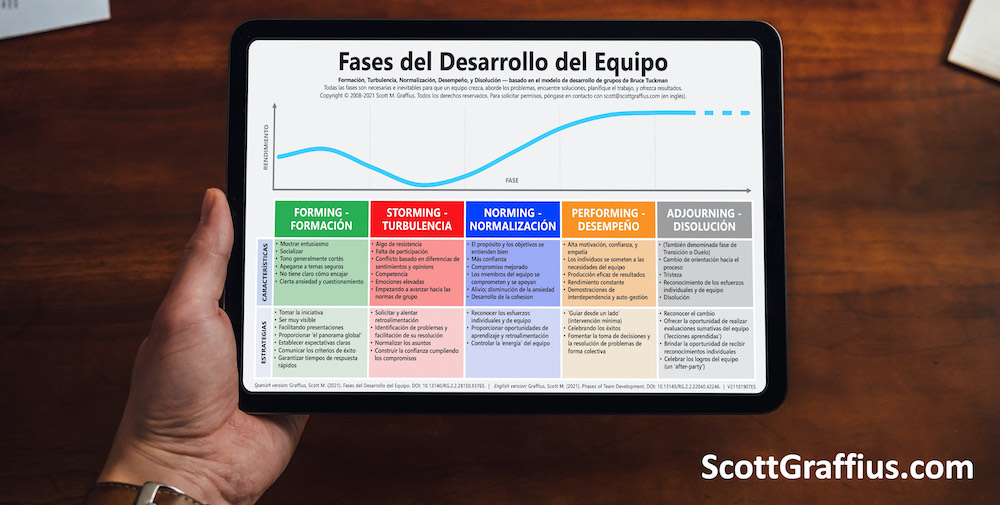
For information on the English version of the Phases of Team Development, visit here.

About Scott M. Graffius

Scott M. Graffius, PMP, CSP-SM, CSP-PO, CSM, CSPO, SFE, ITIL, LSSGB is an agile project management practitioner, consultant, award-winning author, and international speaker. He has generated over one billion dollars of business value in aggregate for the organizations he has served. Graffius is the founder, CEO, and principal consultant at Exceptional PPM and PMO Solutions™ and subsidiary Exceptional Agility™, based in Los Angeles, California. His expertise spans project, program, portfolio, and PMO leadership inclusive of agile, traditional, and hybrid approaches. Content from his books, workshops, speaking engagements, and more have been featured and used by businesses, governments, and universities including Gartner, Microsoft, Deloitte, Oracle, Cisco, Ford, Qantas, Atlassian, Bayer, the National Academy of Sciences, the United States Department of Energy, the United States Army, Project Management Institute, the IEEE, the New Zealand Ministry of Education, Tufts University, Texas A&M University, Virginia Tech, Penn State, Warsaw University of Technology, University of Waterloo, Loughborough University London, and others. Graffius has spoken at 58 conferences and other events around the world, including Armenia, Australia, Brazil, Canada, Czech Republic, Finland, France, Germany, Greece, India, Ireland, Lithuania, Luxembourg, Netherlands, New Zealand, Sweden, United Kingdom, and the United States. Thinkers360 named Graffius a global top thought leader and influencer in four domains: Agile, Change Management, Digital Transformation, and GovTech.
His full bio is available here.
Connect with Scott on:



Copyright
Copyright © Scott M. Graffius. All rights reserved. This material may not be published, broadcast, rewritten or redistributed without the express written permission of Scott M. Graffius.

Bruce Tuckman’s Model (Forming, Storming, Norming, Performing, and Adjourning) is Highly Relevant and Beneficial, But It Doesn’t Please Everyone
08 November 2021
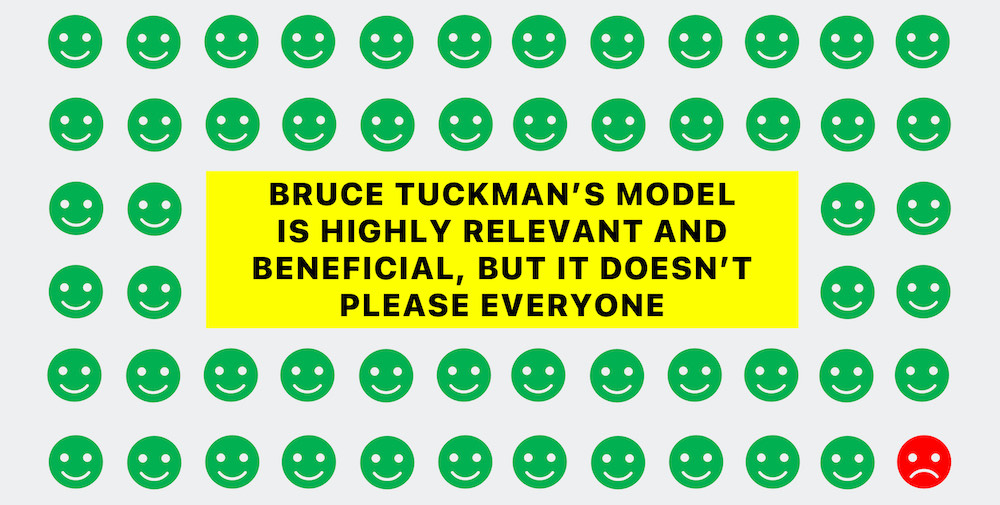
Names and certain identifying details are not included or are redacted (replaced with black rectangles) to respect privacy.

The Question
Steve Jobs famously said: “You can please some of the people some of the time” in response to a tough question at the 1997 Worldwide Developer Conference. The following experience reminded me of that quote.
In a recent workshop on team leadership, a student asked me, “What do you think about █████████’s disregard of Tuckman’s model?” (Note: The student was referring to a person who's a leader in Agile and Scrum. That person's name is redacted, subsequently referred to as “critic.” His or her stance seems to be the rare exception.) I’m detailing my response here.

The Background for Context
Bruce Tuckman (Ph.D. in Psychology from Princeton University) conducted extensive research on group dynamics, and he published a related model in 1965. At that time, the model included four phases: forming, storming, norming, and performing. However, Dr. Tuckman subsequently determined that adjourning was so important that he (with Mary Ann Jensen) updated his model in 1977 to add adjourning as the fifth phase. In the context of this discussion, phases and stages may be used interchangeably; and group dynamics is also referred to as group development, team dynamics, and team development.
Dr. Tuckman’s model has stood the test of time because it remains highly relevant and beneficial. Since his related work was published, it has been supported by additional peer-reviewed research. And it has received recommendations and coverage from leading organizations including Google, Harvard Business Review, IEEE, Forbes, MIT, Fast Company, NASA, Microsoft, TNW, Project Management Institute, Scrum Alliance, Scrum.org, Association for Project Management, Gartner, CIO, Spotify, Imperial College London, RAND Corporation, Princeton University, Software Engineering Institute, University of Edinburgh, Cisco, KPMG, Warsaw University of Technology, DevOps Institute, American Express, SANS Institute, Zurich University, SAP, ViacomCBS, Oxford University, American Management Association, AT&T, University of Southern California, IBM, and many others.
While Tuckman’s model is durable and relevant, no model is perfect. It can be helpful to understand any concerns or limitations—with an emphasis on any which are independently verifiable and are published in peer-reviewed studies.
I related to the student that there are critics of Tuckman’s model, but that they’re few—and I’m not familiar with criticisms meeting the aforementioned rigor of being independently verifiable with such findings appearing in peer-reviewed studies.
I said, for example, that I was already aware of the critic's stated disregard of Bruce Tuckman’s model. I previously looked into the situation to learn more. My research and findings follow.

The Research and Findings
In a █████ communication, the critic said “I never liked ...” referring to Tuckman’s model. He or she went on to state that his or her reason was that “Gersick tested it ...” (Tuckman’s model) and “...it’s not true.” The critic included a link to the paper which was the basis for his or her stance. The link goes to the following paper:
Curtis, B., Walz, D., and Elam, J. (1990, October 1). Studying the Process of Software Design Teams. In: ISPW '90: Proceedings of the 5th International Software Process Workshop on Experience with Software Process Models, pages 52-53.
The critic said that “Gersick tested it” and pointed to the paper. However, Gersick is not an author on the paper. Still, I reviewed the content to see what, if anything, the authors (Curtis, Walz, and Elam) said about Tuckman, Tuckman’s model, and/or Gersick. Here’s what I found.
On Tuckman: Tuckman was not mentioned anywhere in the paper.
On Tuckman’s model (a reference to forming, storming, norming, performing, and/or adjourning): The following appears: “Rather than the standard group process of form-storm-norm-perform, Gersick suggested there came a point halfway through a group project where the team faced its lack of progress.”
On Gersick: Gersick was mentioned four times: “Gersick (1988) observed such a point in a study of project teams” and “Rather than the standard group process of form-storm-norm-perform, Gersick suggested there came a point halfway through a group project where the team faced its lack of progress” and “Gersick's model may be more descriptive of temporary teams that are asked to perform tasks out of their area of expertise” and (a reference citation) “Gersick, C.J.G. (1988). Time and Transition in Work Teams: Toward a New Model of Work Development. Academy of Management Journal, 31 (1), 9-41.”
The critic said that “Gersick tested it” ... and “...it’s not true.” However, as a summary of the above, Gersick is not the author of the paper, and the authors (Curtis, Walz, and Elam) commented that Tuckman’s model did not seem to work for one project. On that one project, “Rather than ... form-storm-norm-perform ... there came a point halfway through ... where the team faced its lack of progress.” That does not negate Tuckman’s model. While teams typically move through the different phases, it’s entirely possible for a team to face a lack of progress at a given time. Phases don’t progress magically; the phase is a marker of the team’s current progress and effectiveness. The critic said that “Gersick tested it” ... and “...it’s not true.” The research specified by the critic did not state that it tested Tuckman’s model and found it to not be true. The research specified by the critic does not support his or her stand. Nevertheless, I dug deeper.
The above paper by Curtis, Walz, and Elam includes Gersick’s work as a reference. I found and carefully reviewed Gersick’s respective research. Again, it’s: “Gersick, C.J.G. (1988). Time and Transition in Work Teams: Toward a New Model of Work Development. Academy of Management Journal, 31 (1), 9-41.” I looked to see what Gersick said about Tuckman or his model. Here’s what I discovered.
Tuckman was mentioned five times: “There was no initial ‘storming’ (Tuckman, 1965; Tuckman & Jensen, 1977) in this group” and “First, as Tuckman pointed out in 1965 and others have noted up to the present (Hare, 1976; McGrath, 1986; Poole, 1983b), they offer snapshots of groups at different points in their life-spans but say little about the mechanisms of change” and “Since all teams were doing construction work on their projects during phase 2, similar to ‘performing’ in Tuckman’s (1965) synthesis, it was a time when teams were more similar to both each other and to the traditional model than they were in phase 1” and (a reference citation) “Tuckman, B. 1965. Developmental Sequence in Small Groups. Psychological Bulletin, 63: 384-399” and (another reference citation) “Tuckman, B., & Jensen, M. 1977. Stages of Small-Group Development. Group and Organizational Studies, 2: 419-427.”
The critic said that “Gersick tested it” ... and “...it’s not true.” However, as a summary of the above, Gersick did not state that Tuckman’s model was tested and found to not be true. For example, Gersick did not say that there was no storming; rather, it was qualified as “no initial ‘storming.’” Furthermore, and most importantly, Gersick provided the following caveat: “This study must be interpreted with caution. It was hypothesis-generating, not hypothesis-testing; the model is expressly provisional.” According to Gersick, the research did not test or prove anything.
The research—both the paper pointed to by the critic, and the reference study—does not supply the stated basis for the critic's stance.

The Conclusion with the Answer
In conclusion, Tuckman’s model has stood the test of time because it remains highly relevant and beneficial. No model is perfect, and it is helpful to understand any concerns or limitations—with an emphasis on any which are independently verifiable and are published in peer-reviewed studies.
My answer to the student’s question (“What do you think about █████████’s disregard of Tuckman’s model?”) was that I diligently reviewed the facts and neither the paper linked to by the critic, nor the other study cited by the paper, support the critic’s assertion that “Gersick tested it ...” (Tuckman’s model) and “...it’s not true.”
Maybe—or maybe not—the critic's view of the model is because of a misunderstanding regarding the research. Or maybe—or maybe not—there's another reason. As Steve Jobs said, “You can please some of the people some of the time.”



The Phases of Team Development Visual
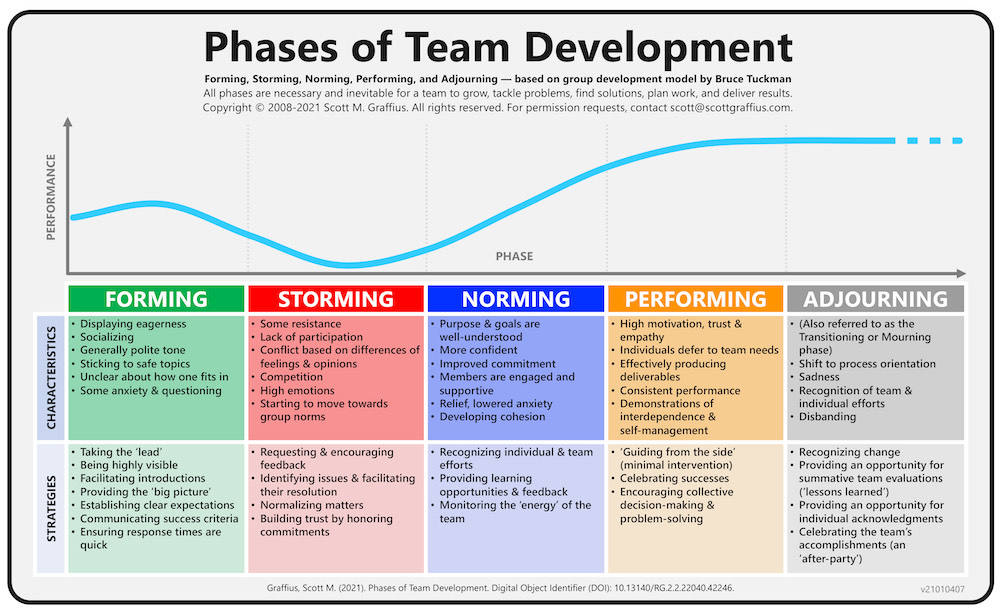
🔥 Update: The newest version is here.

About Scott M. Graffius

Scott M. Graffius, PMP, CSP-SM, CSP-PO, CSM, CSPO, SFE, ITIL, LSSGB is an agile project management practitioner, consultant, award-winning author, and international speaker. He has generated over 1.75 billion dollars of business value in aggregate for the organizations he has served. Graffius is the founder, CEO, and principal consultant at Exceptional PPM and PMO Solutions™ and subsidiary Exceptional Agility™, based in Los Angeles, California. His expertise spans project, program, portfolio, and PMO leadership inclusive of agile, traditional, and hybrid approaches. Content from his books (Agile Scrum and Agile Transformation), workshops, speaking engagements, and more have been featured and used by businesses, governments, and universities including Gartner, Microsoft, Deloitte, Oracle, Cisco, Ford, Qantas, Atlassian, Bayer, the National Academy of Sciences, the United States Department of Energy, the United States Army, Project Management Institute, the IEEE, the New Zealand Ministry of Education, Tufts University, Texas A&M University, Virginia Tech, Penn State, Warsaw University of Technology, University of Waterloo, Loughborough University London, and others. Graffius has spoken at 58 conferences and other events around the world, including Armenia, Australia, Brazil, Canada, Czech Republic, Finland, France, Germany, Greece, India, Ireland, Lithuania, Luxembourg, Netherlands, New Zealand, Sweden, United Kingdom, and the United States. Thinkers360 named Graffius a global top thought leader and influencer in four domains: Agile, Change Management, Digital Transformation, and GovTech.
His full bio is available here.
Connect with Scott on:


About Agile Scrum: Your Quick Start Guide with Step-by-Step Instructions
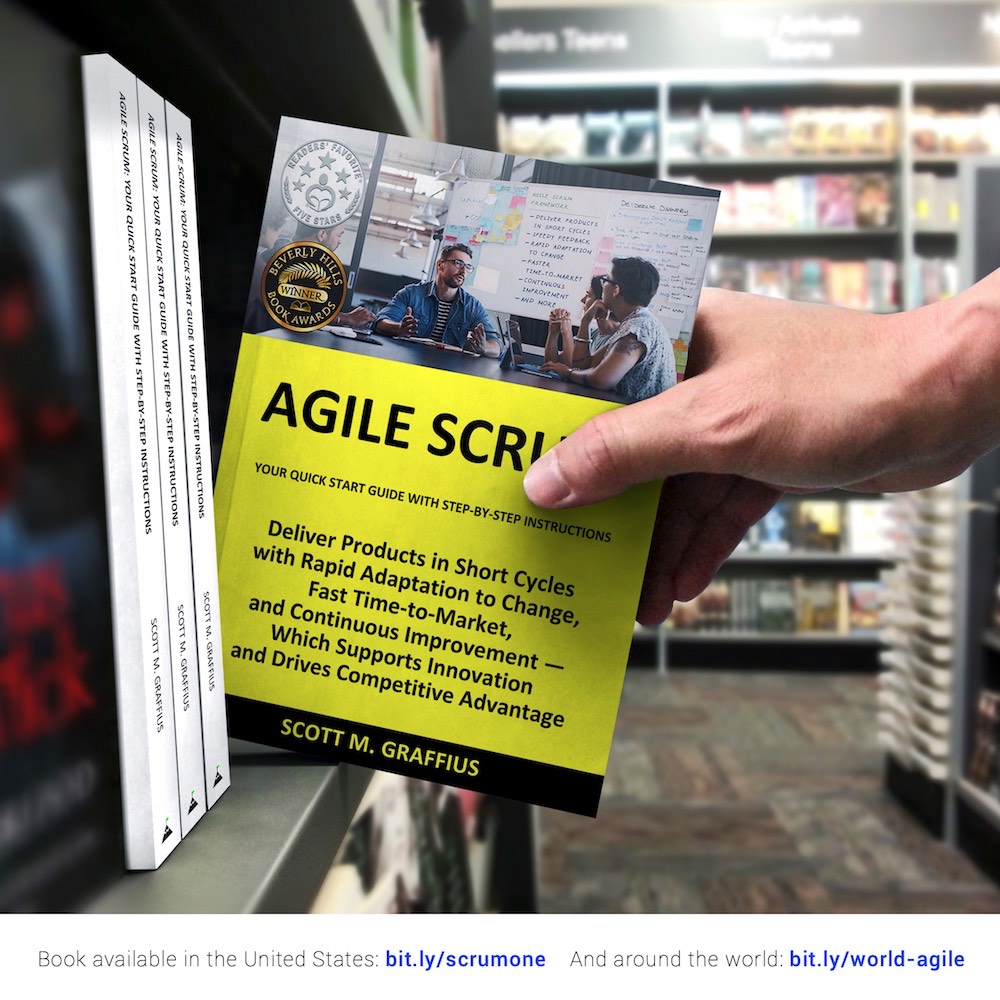
Shifting customer needs are common in today's marketplace. Businesses must be adaptive and responsive to change while delivering an exceptional customer experience to be competitive.
There are a variety of frameworks supporting the development of products and services, and most approaches fall into one of two broad categories: traditional or agile. Traditional practices such as waterfall engage sequential development, while agile involves iterative and incremental deliverables. Organizations are increasingly embracing agile to manage projects, and best meet their business needs of rapid response to change, fast delivery speed, and more.
With clear and easy to follow step-by-step instructions, Scott M. Graffius's award-winning Agile Scrum: Your Quick Start Guide with Step-by-Step Instructions helps the reader:
- Implement and use the most popular agile framework―Scrum;
- Deliver products in short cycles with rapid adaptation to change, fast time-to-market, and continuous improvement; and
- Support innovation and drive competitive advantage.
Hailed by Literary Titan as “the book highlights the versatility of Scrum beautifully.”
Winner of 17 first place awards.
Agile Scrum: Your Quick Start Guide with Step-by-Step Instructions is available in paperback and ebook/Kindle in the United States and around the world. Some links by country follow.
- 🇧🇷 Brazil
- 🇨🇦 Canada
- 🇨🇿 Czech Republic
- 🇩🇰 Denmark
- 🇫🇮 Finland
- 🇫🇷 France
- 🇩🇪 Germany
- 🇬🇷 Greece
- 🇭🇺 Hungary
- 🇮🇳 India
- 🇮🇪 Ireland
- 🇮🇱 Israel
- 🇮🇹 Italy
- 🇯🇵 Japan
- 🇱🇺 Luxembourg
- 🇲🇽 Mexico
- 🇳🇱 Netherlands
- 🇳🇿 New Zealand
- 🇳🇴 Norway
- 🇪🇸 Spain
- 🇸🇪 Sweden
- 🇨🇭 Switzerland
- 🇦🇪 UAE
- 🇬🇧 United Kingdom
- 🇺🇸 United States

About Agile Transformation: A Brief Story of How an Entertainment Company Developed New Capabilities and Unlocked Business Agility to Thrive in an Era of Rapid Change
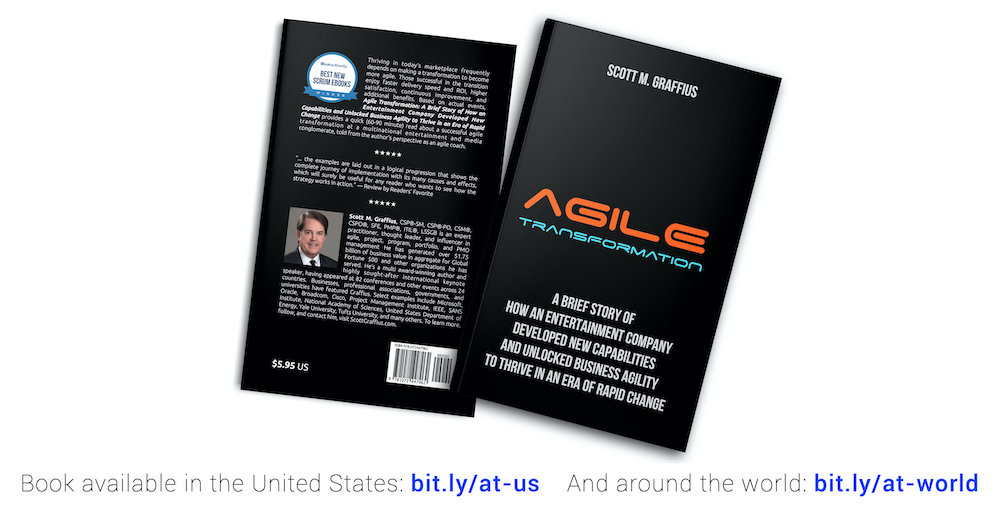
Thriving in today's marketplace frequently depends on making a transformation to become more agile. Those successful in the transition enjoy faster delivery speed and ROI, higher satisfaction, continuous improvement, and additional benefits.
Based on actual events, Agile Transformation: A Brief Story of How an Entertainment Company Developed New Capabilities and Unlocked Business Agility to Thrive in an Era of Rapid Change provides a quick (60-90 minute) read about a successful agile transformation at a multinational entertainment and media company, told from the author's perspective as an agile coach.
The award-winning book by Scott M. Graffius is available in paperback and ebook/Kindle in the United States and around the world. Some links by country follow.
- 🇦🇺 Australia
- 🇦🇹 Austria
- 🇧🇷 Brazil
- 🇨🇦 Canada
- 🇨🇿 Czech Republic
- 🇩🇰 Denmark
- 🇫🇮 Finland
- 🇫🇷 France
- 🇩🇪 Germany
- 🇬🇷 Greece
- 🇮🇳 India
- 🇮🇪 Ireland
- 🇯🇵 Japan
- 🇱🇺 Luxembourg
- 🇲🇽 Mexico
- 🇳🇱 Netherlands
- 🇳🇿 New Zealand
- 🇪🇸 Spain
- 🇸🇪 Sweden
- 🇨🇭 Switzerland
- 🇦🇪 United Arab Emirates
- 🇬🇧 United Kingdom
- 🇺🇸 United States

The short URL for this article is: https://bit.ly/tckmn
Posts related to this article are on Twitter and Instagram (via @AgileScrumGuide)
© Copyright 2021 Scott M. Graffius. All rights reserved. This material may not be published, broadcast, rewritten or redistributed without the express written permission of Scott M. Graffius.

Bruce Tuckman’s Model (Forming, Storming, Norming, Performing, and Adjourning) is Highly Relevant and Beneficial, But It Doesn’t Please Everyone
08 November 2021

Names and certain identifying details are not included or are redacted (replaced with black rectangles) to respect privacy.

The Question
Steve Jobs famously said: “You can please some of the people some of the time” in response to a tough question at the 1997 Worldwide Developer Conference. The following experience reminded me of that quote.
In a recent workshop on team leadership, a student asked me, “What do you think about █████████’s disregard of Tuckman’s model?” (Note: The student was referring to a person who's a leader in Agile and Scrum. That person's name is redacted, subsequently referred to as “critic.” His or her stance seems to be the rare exception.) I’m detailing my response here.

The Background for Context
Bruce Tuckman (Ph.D. in Psychology from Princeton University) conducted extensive research on group dynamics, and he published a related model in 1965. At that time, the model included four phases: forming, storming, norming, and performing. However, Dr. Tuckman subsequently determined that adjourning was so important that he (with Mary Ann Jensen) updated his model in 1977 to add adjourning as the fifth phase. In the context of this discussion, phases and stages may be used interchangeably; and group dynamics is also referred to as group development, team dynamics, and team development.
Dr. Tuckman’s model has stood the test of time because it remains highly relevant and beneficial. Since his related work was published, it has been supported by additional peer-reviewed research. And it has received recommendations and coverage from leading organizations including Google, Harvard Business Review, IEEE, Forbes, MIT, Fast Company, NASA, Microsoft, TNW, Project Management Institute, Scrum Alliance, Scrum.org, Association for Project Management, Gartner, CIO, Spotify, Imperial College London, RAND Corporation, Princeton University, Software Engineering Institute, University of Edinburgh, Cisco, KPMG, Warsaw University of Technology, DevOps Institute, American Express, SANS Institute, Zurich University, SAP, ViacomCBS, Oxford University, American Management Association, AT&T, University of Southern California, IBM, and many others.
While Tuckman’s model is durable and relevant, no model is perfect. It can be helpful to understand any concerns or limitations—with an emphasis on any which are independently verifiable and are published in peer-reviewed studies.
I related to the student that there are critics of Tuckman’s model, but that they’re few—and I’m not familiar with criticisms meeting the aforementioned rigor of being independently verifiable with such findings appearing in peer-reviewed studies.
I said, for example, that I was already aware of the critic's stated disregard of Bruce Tuckman’s model. I previously looked into the situation to learn more. My research and findings follow.

The Research and Findings
In a █████ communication, the critic said “I never liked ...” referring to Tuckman’s model. He or she went on to state that his or her reason was that “Gersick tested it ...” (Tuckman’s model) and “...it’s not true.” The critic included a link to the paper which was the basis for his or her stance. The link goes to the following paper:
Curtis, B., Walz, D., and Elam, J. (1990, October 1). Studying the Process of Software Design Teams. In: ISPW '90: Proceedings of the 5th International Software Process Workshop on Experience with Software Process Models, pages 52-53.
The critic said that “Gersick tested it” and pointed to the paper. However, Gersick is not an author on the paper. Still, I reviewed the content to see what, if anything, the authors (Curtis, Walz, and Elam) said about Tuckman, Tuckman’s model, and/or Gersick. Here’s what I found.
On Tuckman: Tuckman was not mentioned anywhere in the paper.
On Tuckman’s model (a reference to forming, storming, norming, performing, and/or adjourning): The following appears: “Rather than the standard group process of form-storm-norm-perform, Gersick suggested there came a point halfway through a group project where the team faced its lack of progress.”
On Gersick: Gersick was mentioned four times: “Gersick (1988) observed such a point in a study of project teams” and “Rather than the standard group process of form-storm-norm-perform, Gersick suggested there came a point halfway through a group project where the team faced its lack of progress” and “Gersick's model may be more descriptive of temporary teams that are asked to perform tasks out of their area of expertise” and (a reference citation) “Gersick, C.J.G. (1988). Time and Transition in Work Teams: Toward a New Model of Work Development. Academy of Management Journal, 31 (1), 9-41.”
The critic said that “Gersick tested it” ... and “...it’s not true.” However, as a summary of the above, Gersick is not the author of the paper, and the authors (Curtis, Walz, and Elam) commented that Tuckman’s model did not seem to work for one project. On that one project, “Rather than ... form-storm-norm-perform ... there came a point halfway through ... where the team faced its lack of progress.” That does not negate Tuckman’s model. While teams typically move through the different phases, it’s entirely possible for a team to face a lack of progress at a given time. Phases don’t progress magically; the phase is a marker of the team’s current progress and effectiveness. The critic said that “Gersick tested it” ... and “...it’s not true.” The research specified by the critic did not state that it tested Tuckman’s model and found it to not be true. The research specified by the critic does not support his or her stand. Nevertheless, I dug deeper.
The above paper by Curtis, Walz, and Elam includes Gersick’s work as a reference. I found and carefully reviewed Gersick’s respective research. Again, it’s: “Gersick, C.J.G. (1988). Time and Transition in Work Teams: Toward a New Model of Work Development. Academy of Management Journal, 31 (1), 9-41.” I looked to see what Gersick said about Tuckman or his model. Here’s what I discovered.
Tuckman was mentioned five times: “There was no initial ‘storming’ (Tuckman, 1965; Tuckman & Jensen, 1977) in this group” and “First, as Tuckman pointed out in 1965 and others have noted up to the present (Hare, 1976; McGrath, 1986; Poole, 1983b), they offer snapshots of groups at different points in their life-spans but say little about the mechanisms of change” and “Since all teams were doing construction work on their projects during phase 2, similar to ‘performing’ in Tuckman’s (1965) synthesis, it was a time when teams were more similar to both each other and to the traditional model than they were in phase 1” and (a reference citation) “Tuckman, B. 1965. Developmental Sequence in Small Groups. Psychological Bulletin, 63: 384-399” and (another reference citation) “Tuckman, B., & Jensen, M. 1977. Stages of Small-Group Development. Group and Organizational Studies, 2: 419-427.”
The critic said that “Gersick tested it” ... and “...it’s not true.” However, as a summary of the above, Gersick did not state that Tuckman’s model was tested and found to not be true. For example, Gersick did not say that there was no storming; rather, it was qualified as “no initial ‘storming.’” Furthermore, and most importantly, Gersick provided the following caveat: “This study must be interpreted with caution. It was hypothesis-generating, not hypothesis-testing; the model is expressly provisional.” According to Gersick, the research did not test or prove anything.
The research—both the paper pointed to by the critic, and the reference study—does not supply the stated basis for the critic's stance.

The Conclusion with the Answer
In conclusion, Tuckman’s model has stood the test of time because it remains highly relevant and beneficial. No model is perfect, and it is helpful to understand any concerns or limitations—with an emphasis on any which are independently verifiable and are published in peer-reviewed studies.
My answer to the student’s question (“What do you think about █████████’s disregard of Tuckman’s model?”) was that I diligently reviewed the facts and neither the paper linked to by the critic, nor the other study cited by the paper, support the critic’s assertion that “Gersick tested it ...” (Tuckman’s model) and “...it’s not true.”
Maybe—or maybe not—the critic's view of the model is because of a misunderstanding regarding the research. Or maybe—or maybe not—there's another reason. As Steve Jobs said, “You can please some of the people some of the time.”



The Phases of Team Development Visual

🔥 Update: The newest version is here.

About Scott M. Graffius

Scott M. Graffius, PMP, CSP-SM, CSP-PO, CSM, CSPO, SFE, ITIL, LSSGB is an agile project management practitioner, consultant, award-winning author, and international speaker. He has generated over 1.75 billion dollars of business value in aggregate for the organizations he has served. Graffius is the founder, CEO, and principal consultant at Exceptional PPM and PMO Solutions™ and subsidiary Exceptional Agility™, based in Los Angeles, California. His expertise spans project, program, portfolio, and PMO leadership inclusive of agile, traditional, and hybrid approaches. Content from his books (Agile Scrum and Agile Transformation), workshops, speaking engagements, and more have been featured and used by businesses, governments, and universities including Gartner, Microsoft, Deloitte, Oracle, Cisco, Ford, Qantas, Atlassian, Bayer, the National Academy of Sciences, the United States Department of Energy, the United States Army, Project Management Institute, the IEEE, the New Zealand Ministry of Education, Tufts University, Texas A&M University, Virginia Tech, Penn State, Warsaw University of Technology, University of Waterloo, Loughborough University London, and others. Graffius has spoken at 58 conferences and other events around the world, including Armenia, Australia, Brazil, Canada, Czech Republic, Finland, France, Germany, Greece, India, Ireland, Lithuania, Luxembourg, Netherlands, New Zealand, Sweden, United Kingdom, and the United States. Thinkers360 named Graffius a global top thought leader and influencer in four domains: Agile, Change Management, Digital Transformation, and GovTech.
His full bio is available here.
Connect with Scott on:


About Agile Scrum: Your Quick Start Guide with Step-by-Step Instructions

Shifting customer needs are common in today's marketplace. Businesses must be adaptive and responsive to change while delivering an exceptional customer experience to be competitive.
There are a variety of frameworks supporting the development of products and services, and most approaches fall into one of two broad categories: traditional or agile. Traditional practices such as waterfall engage sequential development, while agile involves iterative and incremental deliverables. Organizations are increasingly embracing agile to manage projects, and best meet their business needs of rapid response to change, fast delivery speed, and more.
With clear and easy to follow step-by-step instructions, Scott M. Graffius's award-winning Agile Scrum: Your Quick Start Guide with Step-by-Step Instructions helps the reader:
- Implement and use the most popular agile framework―Scrum;
- Deliver products in short cycles with rapid adaptation to change, fast time-to-market, and continuous improvement; and
- Support innovation and drive competitive advantage.
Hailed by Literary Titan as “the book highlights the versatility of Scrum beautifully.”
Winner of 17 first place awards.
Agile Scrum: Your Quick Start Guide with Step-by-Step Instructions is available in paperback and ebook/Kindle in the United States and around the world. Some links by country follow.
- 🇧🇷 Brazil
- 🇨🇦 Canada
- 🇨🇿 Czech Republic
- 🇩🇰 Denmark
- 🇫🇮 Finland
- 🇫🇷 France
- 🇩🇪 Germany
- 🇬🇷 Greece
- 🇭🇺 Hungary
- 🇮🇳 India
- 🇮🇪 Ireland
- 🇮🇱 Israel
- 🇮🇹 Italy
- 🇯🇵 Japan
- 🇱🇺 Luxembourg
- 🇲🇽 Mexico
- 🇳🇱 Netherlands
- 🇳🇿 New Zealand
- 🇳🇴 Norway
- 🇪🇸 Spain
- 🇸🇪 Sweden
- 🇨🇭 Switzerland
- 🇦🇪 UAE
- 🇬🇧 United Kingdom
- 🇺🇸 United States

About Agile Transformation: A Brief Story of How an Entertainment Company Developed New Capabilities and Unlocked Business Agility to Thrive in an Era of Rapid Change

Thriving in today's marketplace frequently depends on making a transformation to become more agile. Those successful in the transition enjoy faster delivery speed and ROI, higher satisfaction, continuous improvement, and additional benefits.
Based on actual events, Agile Transformation: A Brief Story of How an Entertainment Company Developed New Capabilities and Unlocked Business Agility to Thrive in an Era of Rapid Change provides a quick (60-90 minute) read about a successful agile transformation at a multinational entertainment and media company, told from the author's perspective as an agile coach.
The award-winning book by Scott M. Graffius is available in paperback and ebook/Kindle in the United States and around the world. Some links by country follow.
- 🇦🇺 Australia
- 🇦🇹 Austria
- 🇧🇷 Brazil
- 🇨🇦 Canada
- 🇨🇿 Czech Republic
- 🇩🇰 Denmark
- 🇫🇮 Finland
- 🇫🇷 France
- 🇩🇪 Germany
- 🇬🇷 Greece
- 🇮🇳 India
- 🇮🇪 Ireland
- 🇯🇵 Japan
- 🇱🇺 Luxembourg
- 🇲🇽 Mexico
- 🇳🇱 Netherlands
- 🇳🇿 New Zealand
- 🇪🇸 Spain
- 🇸🇪 Sweden
- 🇨🇭 Switzerland
- 🇦🇪 United Arab Emirates
- 🇬🇧 United Kingdom
- 🇺🇸 United States

The short URL for this article is: https://bit.ly/tckmn
Posts related to this article are on Twitter and Instagram (via @AgileScrumGuide)
© Copyright 2021 Scott M. Graffius. All rights reserved. This material may not be published, broadcast, rewritten or redistributed without the express written permission of Scott M. Graffius.

Most Valuable IT Certifications: Update for 2024
15 March 2024
BY SCOTT M. GRAFFIUS | ScottGraffius.com



In Technology, there's no substitute for experience. However, certifications remain a valuable tool for advancing one's career.
In 2017, Scott M. Graffius started developing and reporting information on the most valuable Information Technology (IT) certifications. As technology advances and marketplace needs evolve over time, the skills and knowledge required to succeed can also change. For that reason, Graffius periodically updates his respective work. This article provides the 2024 update for the most valuable IT certifications.


Certifications can help position people as a valuable asset to their current — and prospective future — employers.
Employers want employees and candidates with up-to-date knowledge and skills, and certifications demonstrate a person’s mastery of the respective subject. Additionally, certifications can advance a person’s marketability and lead to promotions and higher pay.
Graffius compiled and analyzed data from 12 sources — Exceptional Agility, California Institute of Arts and Technology, CIO, CIO Dive, ComputerScience(dot)org, eWeek, Fortune, Global Knowledge, Indeed, PC Magazine, Robert Half, and Skillsoft — to determine the general consensus on the most valuable IT related certifications. Eleven certifications emerged.
Now, on to this list!

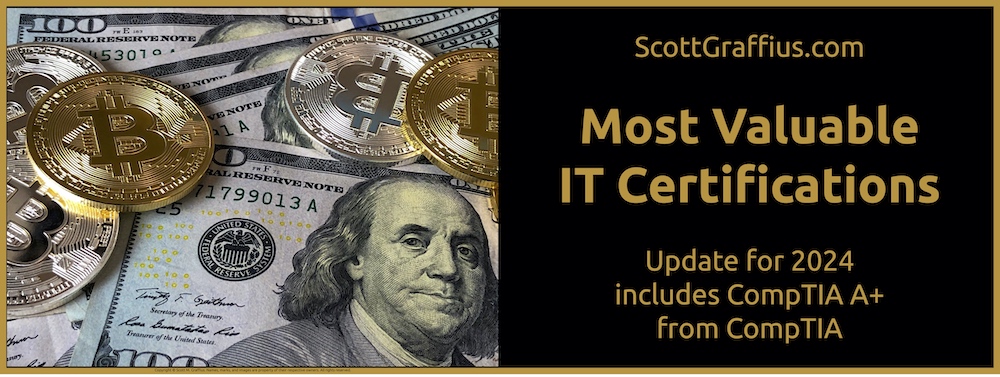
1. CompTIA A+
Note: Prerequisites, cost (shown in United States Dollar - USD), and other data are subject to change by the governing organization.

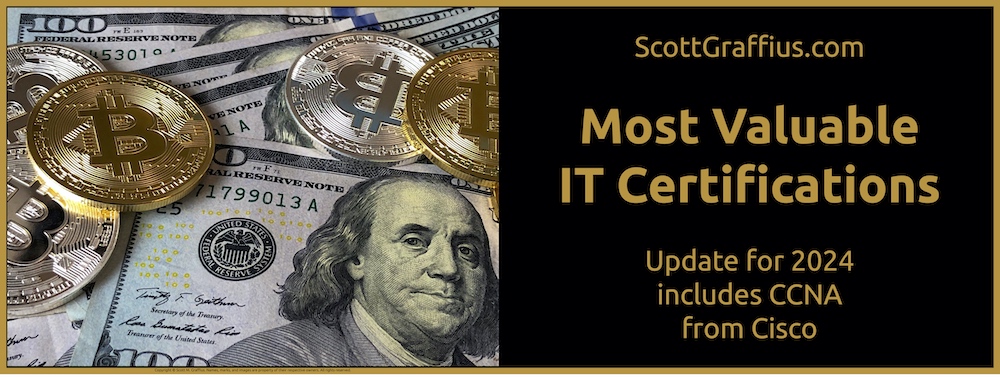
2. Cisco Certified Network Associate
Note: Prerequisites, cost (shown in United States Dollar - USD), and other data are subject to change by the governing organization.

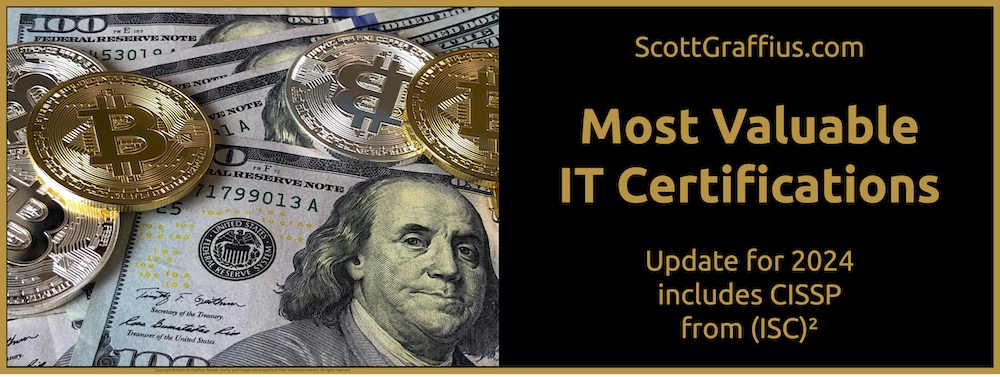
3. Certified Information Systems Security Professional
Note: Prerequisites, cost (shown in United States Dollar - USD), and other data are subject to change by the governing organization.

4. Project Management Professional
Note: Prerequisites, cost (shown in United States Dollar - USD), and other data are subject to change by the governing organization.

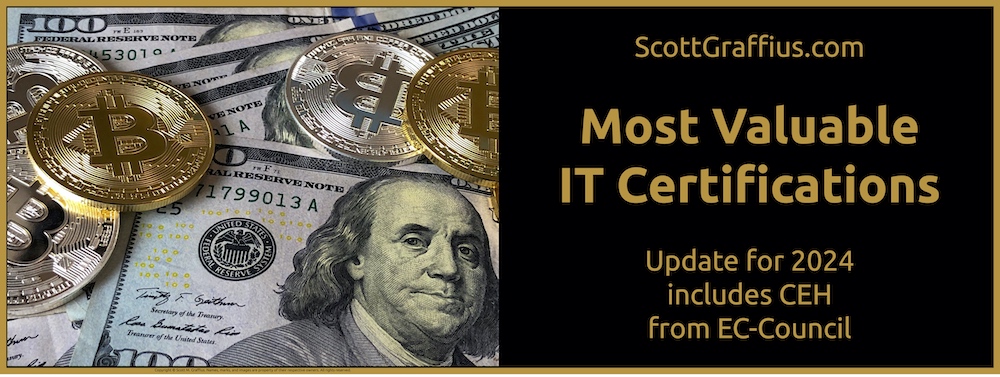
5. Certified Ethical Hacker
Note: Prerequisites, cost (shown in United States Dollar - USD), and other data are subject to change by the governing organization.

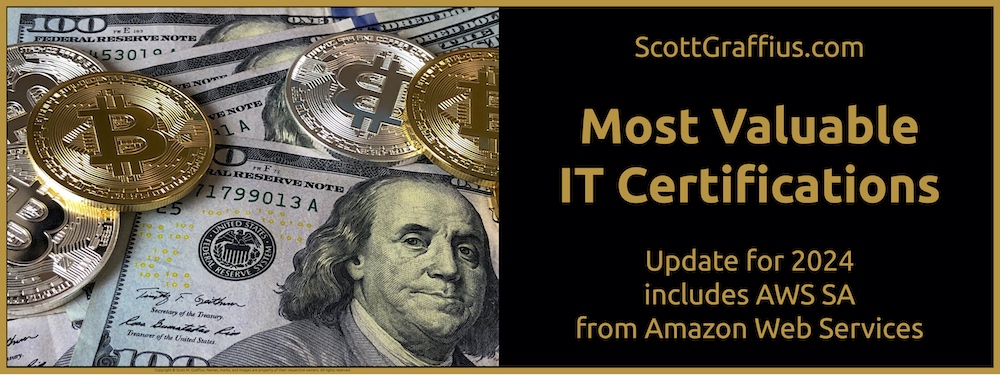
6. AWS Certified Solutions Architect - Associate
Note: Prerequisites, cost (shown in United States Dollar - USD), and other data are subject to change by the governing organization.

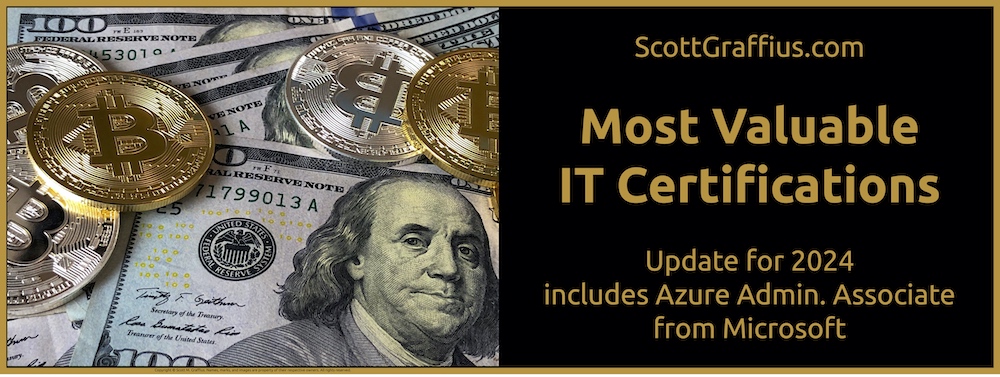
7. Azure Administrator Associate
Note: Prerequisites, cost (shown in United States Dollar - USD), and other data are subject to change by the governing organization.

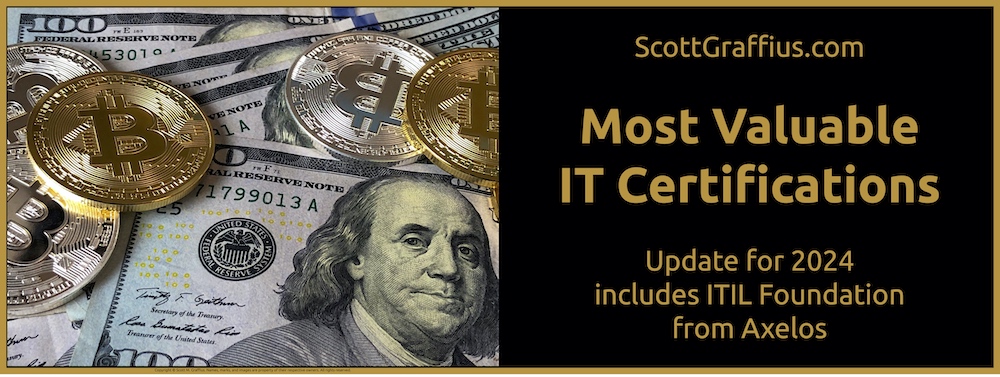
8. ITIL Foundation
Note: Prerequisites, cost (shown in United States Dollar - USD), and other data are subject to change by the governing organization.

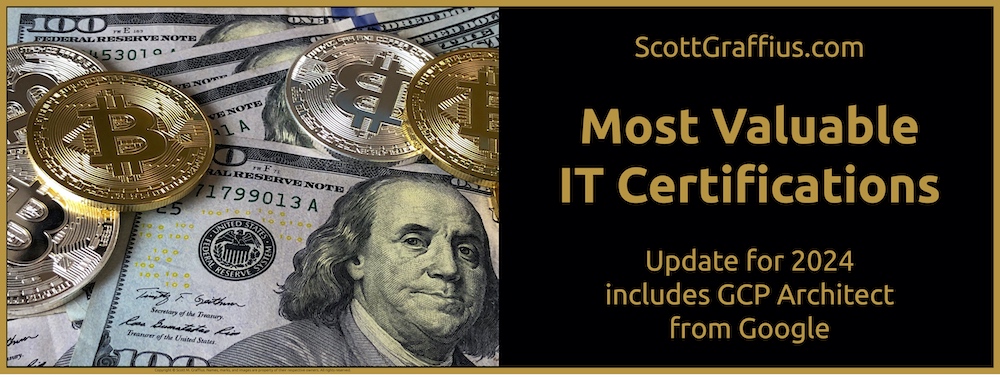
9. Google Certified Professional Cloud Architect
Note: Prerequisites, cost (shown in United States Dollar - USD), and other data are subject to change by the governing organization.

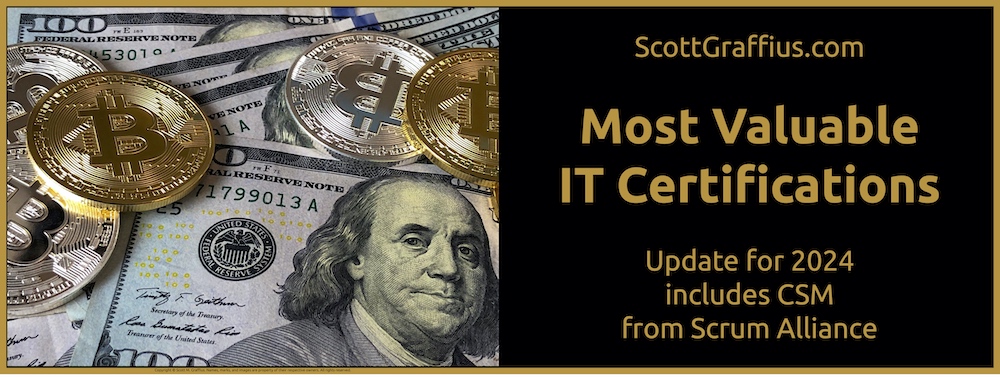
10. Certified ScrumMaster
Note: Prerequisites, cost (shown in United States Dollar - USD), and other data are subject to change by the governing organization.

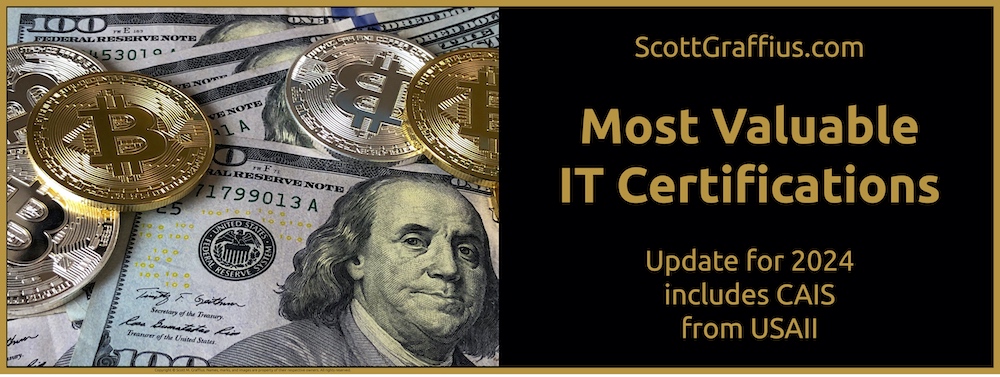
11. Certified Artificial Intelligence Scientist
Note: Prerequisites, cost (shown in United States Dollar - USD), and other data are subject to change by the governing organization.


Certifications can provide significant value for professionals looking to enhance their skills and credibility in the marketplace. Employers often prefer to hire certified professionals, and people who invest in professional credentials typically enjoy larger salaries.
Informed by data from multiple sources, this article identified and profiled 11 IT related certifications: CompTIA A+, Cisco Certified Network Associate (CCNA), Certified Information Systems Security Professional (CISSP), Project Management Professional (PMP), Certified Ethical Hacker (CEH), AWS Certified Solutions Architect - Associate (AWS SA), Azure Administrator Associate, ITIL Foundations (ITIL), Google Certified Professional Cloud Architect (GCP Architect), Certified ScrumMaster (CSM), and Certified Artificial Intelligence Scientist (CAIS).
Those interested in securing one or more IT related certifications can leverage the information presented in this article to assist in their decision-making.


References/Sources:


How to Cite This Article
Graffius, Scott M. (2024, March 15). Most Valuable IT Certifications: Update for 2024. Available at: https://scottgraffius.com/blog/files/it-certs-2024.html. DOI: 10.13140/RG.2.2.11776.03849.




About Scott M. Graffius

Scott M. Graffius, PMP, SA, CSP-SM, CSP-PO, CSM, CSPO, ITIL, LSSGB is an agile project management practitioner, consultant, thinker, creator, multi-award-winning author, and international public speaker. Founder and CEO of Exceptional PPM and PMO Solutions™ and subsidiary Exceptional Agility™, he has generated over $1.9 billion for Global Fortune 500 businesses and other organizations he has served. Graffius and content from his books, talks, workshops, and more have been featured and used by Microsoft, Oracle, Broadcom, Cisco, Gartner, Project Management Institute, IEEE, National Academy of Sciences, United States Department of Energy, Yale University, Tufts University, and others. He delights audiences with dynamic and engaging talks and workshops on agile project management, AI, Tech leadership, video game development, strategic alignment, the science of high performance teams, and more. To date, he's presented sessions at 89 conferences and other events across 25 countries.
His full bio is available here.
Connect with Scott on:

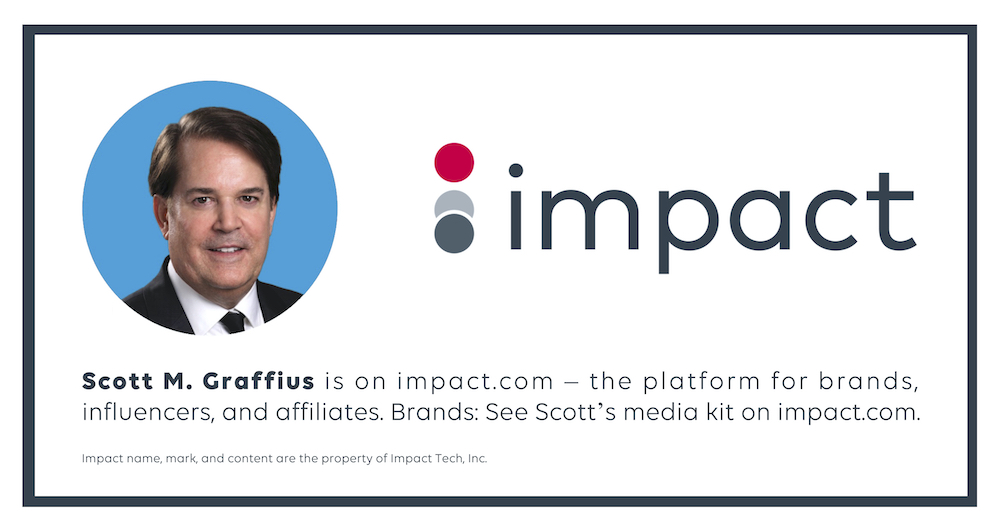

About Agile Scrum: Your Quick Start Guide with Step-by-Step Instructions

Shifting customer needs are common in today's marketplace. Businesses must be adaptive and responsive to change while delivering an exceptional customer experience to be competitive.
There are a variety of frameworks supporting the development of products and services, and most approaches fall into one of two broad categories: traditional or agile. Traditional practices such as waterfall engage sequential development, while agile involves iterative and incremental deliverables. Organizations are increasingly embracing agile to manage projects, and best meet their business needs of rapid response to change, fast delivery speed, and more.
With clear and easy to follow step-by-step instructions, Scott M. Graffius's award-winning Agile Scrum: Your Quick Start Guide with Step-by-Step Instructions helps the reader:
Hailed by Literary Titan as “the book highlights the versatility of Scrum beautifully.”
Winner of 17 first place awards.
Agile Scrum: Your Quick Start Guide with Step-by-Step Instructions is available in paperback and ebook/Kindle in the United States and around the world. Some links by country follow.

About Agile Transformation: A Brief Story of How an Entertainment Company Developed New Capabilities and Unlocked Business Agility to Thrive in an Era of Rapid Change

Thriving in today's marketplace frequently depends on making a transformation to become more agile. Those successful in the transition enjoy faster delivery speed and ROI, higher satisfaction, continuous improvement, and additional benefits.
Based on actual events, Agile Transformation: A Brief Story of How an Entertainment Company Developed New Capabilities and Unlocked Business Agility to Thrive in an Era of Rapid Change provides a quick (60-90 minute) read about a successful agile transformation at a multinational entertainment and media company, told from the author's perspective as an agile coach.
The award-winning book by Scott M. Graffius is available in paperback and ebook/Kindle in the United States and around the world. Some links by country follow.

The short link for this article is: https://bit.ly/it-certs
© Copyright 2024 Scott M. Graffius. All rights reserved. This material may not be published, broadcast, rewritten or redistributed without the express written permission of Scott M. Graffius.




In Technology, there's no substitute for experience. However, certifications remain a valuable tool for advancing one's career.
In 2017, Scott M. Graffius started developing and reporting information on the most valuable Information Technology (IT) certifications. As technology advances and marketplace needs evolve over time, the skills and knowledge required to succeed can also change. For that reason, Graffius periodically updates his respective work. This article provides the 2024 update for the most valuable IT certifications.


Certifications can help position people as a valuable asset to their current — and prospective future — employers.
Employers want employees and candidates with up-to-date knowledge and skills, and certifications demonstrate a person’s mastery of the respective subject. Additionally, certifications can advance a person’s marketability and lead to promotions and higher pay.
Graffius compiled and analyzed data from 12 sources — Exceptional Agility, California Institute of Arts and Technology, CIO, CIO Dive, ComputerScience(dot)org, eWeek, Fortune, Global Knowledge, Indeed, PC Magazine, Robert Half, and Skillsoft — to determine the general consensus on the most valuable IT related certifications. Eleven certifications emerged.
Now, on to this list!


1. CompTIA A+
- Certification name: CompTIA A+
- Certification name abbreviation: A+
- Governing organization - name: CompTIA
- Governing organization - website: https://www.comptia.org
- Short description of certification: This is generally considered to be a certification for people who want to start careers in the IT industry. To acquire the CompTIA A+ certification, you must pass two separate tests: Core 1 and Core 2. Core 1 (220-1101) covers mobile devices, networking technology, hardware, virtualization, and cloud computing. Core 2 (220-1102) covers operating systems, security, software, and operational procedures.
- Prerequisites (if any) for certification: None
- Certification exam – cost: Total cost for the two exams varies by location and other factors. The average total combined cost is $492
- Certification exam – delivery (in-person or online): in-person or online
- Certification exam – number of questions: Core 1 exam has 90 questions, Core 2 exam also has 90 questions
- Certification exam – time to complete it: 90 minutes for Core 1 exam, and 90 minutes for Core 2 exam
- Certification exam – minimum pass rate (X% or higher correct required to pass exam): Estimated to be 83% for the Core 1 exam. Estimated to be 86% for the Core 2 exam.
- Certification expiration – does it expire? Yes
- Certification expiration – how long does it last before expiring? 3 years
- Certification renewal cost: $75
Note: Prerequisites, cost (shown in United States Dollar - USD), and other data are subject to change by the governing organization.


2. Cisco Certified Network Associate
- Certification name: Cisco Certified Network Associate
- Certification name abbreviation: CCNA
- Governing organization - name: Cisco
- Governing organization - website: https://www.cisco.com
- Short description of certification: Validates the ability to install, operate, configure, and troubleshoot basic Cisco networking devices and technologies.
- Prerequisites (if any) for certification: No prerequisites. However, Cisco recommends having at least a basic knowledge of networking and at least one year of experience with Cisco products.
- Certification exam – cost: $300
- Certification exam – delivery (in-person or online): In-person or online
- Certification exam – number of questions: Varies, between 50-75 questions
- Certification exam – time to complete it: 120 minutes
- Certification exam – minimum pass rate (X% or higher correct required to pass exam): Estimated to be 80%
- Certification expiration – does it expire? Yes
- Certification expiration – how long does it last before expiring? 3 years
- Certification renewal cost: $150
Note: Prerequisites, cost (shown in United States Dollar - USD), and other data are subject to change by the governing organization.


3. Certified Information Systems Security Professional
- Certification name: Certified Information Systems Security Professional
- Certification name abbreviation: CISSP
- Governing organization - name: (ISC)²
- Governing organization - website: https://www.isc2.org
- Short description of certification: The CISSP is a highly respective, vendor-neutral certification that validates a broad understanding of information security and best practices.
- Prerequisites (if any) for certification: At least five years of paid, full time work experience involving two or more (of the eight) domains of the CISSP Common Body of Knowledge (CBK)
- Certification exam - cost: $749, although the cost may vary by location and other factors
- Certification exam - delivery (in-person or online): In-person at a Pearson VUE testing center
- Certification exam - number of questions: Between 125-175 questions
- Certification exam - time to complete it: 4 hours
- Certification exam - minimum pass rate (X% or higher correct required to pass exam): Estimated to be 70%
- Certification expiration - does it expire? Yes
- Certification expiration - how long does it last before expiring? 3 years
- Certification renewal cost: $125
Note: Prerequisites, cost (shown in United States Dollar - USD), and other data are subject to change by the governing organization.

4. Project Management Professional
- Certification name: Project Management Professional
- Certification name abbreviation: PMP
- Governing organization - name: Project Management Institute (PMI)
- Governing organization - website: https://www.pmi.org/
- Short description of certification: PMP certification is a globally recognized and sought-after project management credential that recognizes experienced project managers for successfully leading teams through a project’s life cycle.
- Prerequisites (if any) for certification: A or B. (A) Bachelor's degree (or global equivalent) + 36 months of project management experience + 35 hours of project management education/training. Or (B) Secondary degree (high school diploma, associate’s degree or global equivalent) + 60 months of project management experience + 35 hours of project management education/training.
- Certification exam - cost: $405 for members of the PMI, $575 for those not a member of the PMI
- Certification exam - delivery (in-person or online): In-person
- Certification exam - number of questions: Between 180-200 questions
- Certification exam - time to complete it: 230 minutes
- Certification exam - minimum pass rate (X% or higher correct required to pass exam): Estimated to be 81%
- Certification expiration - does it expire? Yes
- Certification expiration - how long does it last before expiring? 3 years
- Certification renewal cost: $150
Note: Prerequisites, cost (shown in United States Dollar - USD), and other data are subject to change by the governing organization.


5. Certified Ethical Hacker
- Certification name: Certified Ethical Hacker
- Certification name abbreviation: CEH
- Governing organization - name: EC-Council
- Governing organization - website: https://www.eccouncil.org
- Short description of certification: This certification is obtained by demonstrating knowledge of assessing the security of computer systems by looking for vulnerabilities in target systems, using the same knowledge and tools as a malicious hacker, but in a lawful and legitimate manner to assess the security posture of a target system.
- Prerequisites (if any) for certification: Candidates need to have experience in a job related to network security or complete approved training courses before taking the exam
- Certification exam - cost: $1,199, can vary based on registration options and other factors
- Certification exam - delivery (in-person or online): In-person at a Pearson VUE testing center or online proctored
- Certification exam - number of questions: 125
- Certification exam - time to complete it: 4 hours
- Certification exam - minimum pass rate (X% or higher correct required to pass exam): Estimated to be 70%
- Certification expiration - does it expire? Yes
- Certification expiration - how long does it last before expiring? 3 years
- Certification renewal cost: $85
Note: Prerequisites, cost (shown in United States Dollar - USD), and other data are subject to change by the governing organization.


6. AWS Certified Solutions Architect - Associate
- Certification name: AWS Certified Solutions Architect - Associate
- Certification name abbreviation: AWS SA
- Governing organization - name: Amazon Web Services (AWS)
- Governing organization - website: http://aws.amazon.com
- Short description of certification: This certification showcases knowledge and skills in AWS technology, across a wide range of AWS services. The focus is on the design of cost- and performance-optimized solutions, demonstrating a strong understanding of the AWS Well-Architected Framework.
- Prerequisites (if any) for certification: None
- Certification exam - cost: $150
- Certification exam - delivery (in-person or online): In-person or online
- Certification exam - number of questions: 65 questions
- Certification exam - time to complete it: 130 minutes
- Certification exam - minimum pass rate (X% or higher correct required to pass exam): Estimated to be 70%
- Certification expiration - does it expire? Yes
- Certification expiration - how long does it last before expiring? 3 years
- Certification renewal cost: $75
Note: Prerequisites, cost (shown in United States Dollar - USD), and other data are subject to change by the governing organization.


7. Azure Administrator Associate
- Certification name: Azure Administrator Associate
- Certification name abbreviation: There isn't an abbreviation designated. AZ-104 (the corresponding exam code for the certification) is sometimes used as an identifier.
- Governing organization - name: Microsoft
- Governing organization - website: https://learn.microsoft.com
- Short description of certification: Azure Administrator Associate (also referred to as Microsoft Certified: Azure Administrator Associate) certification validates one’s ability to manage Azure subscriptions, implement and secure infrastructure, configure virtual networks, deploy virtual machines, monitor resources, and troubleshoot issues.
- Prerequisites (if any) for certification: None, but Microsoft recommends at least six months of experience administering Azure
- Certification exam - cost: $165
- Certification exam - delivery (in-person or online): In-person or online proctored
- Certification exam - number of questions: Varies, typically between 40-60 questions
- Certification exam - time to complete it: 120 minutes
- Certification exam - minimum pass rate (X% or higher correct required to pass exam): Estimated to be 70%
- Certification expiration - does it expire? Yes
- Certification expiration - how long does it last before expiring? 1 year
- Certification renewal cost: Free renewal
Note: Prerequisites, cost (shown in United States Dollar - USD), and other data are subject to change by the governing organization.


8. ITIL Foundation
- Certification name: ITIL Foundation
- Certification name abbreviation: ITIL
- Governing organization - name: Axelos
- Governing organization - website: https://www.axelos.com
- Short description of certification: Provides a foundation in IT service management (ITSM) best practices. Covers key concepts, service lifecycle, and the benefits of effective ITSM.
- Prerequisites (if any) for certification: None
- Certification exam - cost: $330
- Certification exam - delivery (in-person or online): In-person or online
- Certification exam - number of questions: 40 questions
- Certification exam - time to complete it: 60 minutes
- Certification exam - minimum pass rate (X% or higher correct required to pass exam): Some sources indicate it is 65%, others estimate it to be 70%
- Certification expiration - does it expire? No
- Certification expiration - how long does it last before expiring? Not applicable; certification does not expire
- Certification renewal cost: Not applicable; certification does not expire
Note: Prerequisites, cost (shown in United States Dollar - USD), and other data are subject to change by the governing organization.


9. Google Certified Professional Cloud Architect
- Certification name: Google Certified Professional Cloud Architect
- Certification name abbreviation: GCP Architect
- Governing organization - name: Google
- Governing organization - website: https://cloud.google.com
- Short description of certification: Demonstrates expertise in designing, developing, and managing secure, reliable, scalable, and cost-effective solutions on the Google Cloud Platforms (GCP)
- Prerequisites (if any) for certification: None; familiarity with GCP products and services is recommended
- Certification exam - cost: $200
- Certification exam - delivery (in-person or online): In-person
- Certification exam - number of questions: 50 questions
- Certification exam - time to complete it: 120 minutes
- Certification exam - minimum pass rate (X% or higher correct required to pass exam): Estimated to be 70%
- Certification expiration - does it expire? Yes
- Certification expiration - how long does it last before expiring? 2 years
- Certification renewal cost: $100
Note: Prerequisites, cost (shown in United States Dollar - USD), and other data are subject to change by the governing organization.


10. Certified ScrumMaster
- Certification name: Certified ScrumMaster
- Certification name abbreviation: CSM
- Governing organization - name: Scrum Alliance
- Governing organization - website: https://www.scrumalliance.org
- Short description of certification: Validates a solid understanding of Scrum including practical ways to apply it on one’s team and organization
- Prerequisites (if any) for certification: Completion of a two-day course by an authorized trainer
- Certification exam - cost: Course (referenced above) includes the cost of the exam. Cost ranges from about $500 to $1,500 depending on the location, delivery format, and other factors
- Certification exam - delivery (in-person or online): Online
- Certification exam - number of questions: 50
- Certification exam - time to complete it: 1 hour
- Certification exam - minimum pass rate (X% or higher correct required to pass exam): Estimated to be 74%
- Certification expiration - does it expire? Yes
- Certification expiration - how long does it last before expiring? 2 years
- Certification renewal cost: $100
Note: Prerequisites, cost (shown in United States Dollar - USD), and other data are subject to change by the governing organization.


11. Certified Artificial Intelligence Scientist
- Certification name: Certified Artificial Intelligence Scientist
- Certification name abbreviation: CAIS
- Governing organization - name: United States Artificial Intelligence Institute (USAII)
- Governing organization - website: https://www.usaii.org
- Short description of certification: The CAIS is publicized by USAII as the most sophisticated and ground-breaking certification program for senior AI professionals and business leaders to develop the perfect AI solutions and strategy, bringing the right organizational change leading to an absolute business transformation.
- Prerequisites (if any) for certification: One of three eligibility paths and completion of a self-paced course. Path 1: Bachelor's degree (or equivalent) in any academic discipline; and at least five years of experience in Artificial Intelligence, Machine Learning, Data Science, Business Analytics, Business Intelligence, Project Management, or any Programming Languages. Path 2: Bachelor's degree (or equivalent) in any academic discipline; and at least four years of experience in Artificial Intelligence, Machine Learning, Data Science, Business Analytics, Business Intelligence, Engineering, Finance, or Management. Path 3: Certified Artificial Intelligence Consultant (CAIC) (or other equivalent) certification; and at least four years of experience for a candidate who has a Bachelor's degree (or equivalent), or three years of experience for a candidate who has a Master's degree (or equivalent).
- Certification exam - cost: Course (referenced above) includes the cost of the exam. Cost is $894.
- Certification exam - delivery (in-person or online): In-person
- Certification exam - number of questions: 80
- Certification exam - time to complete it: 100 minutes
- Certification exam - minimum pass rate (X% or higher correct required to pass exam): 70%
- Certification expiration - does it expire? Yes
- Certification expiration - how long does it last before expiring? 3 years
- Certification renewal cost: $249
Note: Prerequisites, cost (shown in United States Dollar - USD), and other data are subject to change by the governing organization.


Certifications can provide significant value for professionals looking to enhance their skills and credibility in the marketplace. Employers often prefer to hire certified professionals, and people who invest in professional credentials typically enjoy larger salaries.
Informed by data from multiple sources, this article identified and profiled 11 IT related certifications: CompTIA A+, Cisco Certified Network Associate (CCNA), Certified Information Systems Security Professional (CISSP), Project Management Professional (PMP), Certified Ethical Hacker (CEH), AWS Certified Solutions Architect - Associate (AWS SA), Azure Administrator Associate, ITIL Foundations (ITIL), Google Certified Professional Cloud Architect (GCP Architect), Certified ScrumMaster (CSM), and Certified Artificial Intelligence Scientist (CAIS).
Those interested in securing one or more IT related certifications can leverage the information presented in this article to assist in their decision-making.


References/Sources:
- Exceptional Agility (2024, January 4). Top Agile Certifications: Update for 2024. Available at: https://exceptionalagility.com/blog/files/top-agile-certifications-2024.html.
- California Institute of Arts and Technology (CIAT) (2024, February). 10 In-Demand IT Jobs You Can Get With Tech Certifications. Available at: https://www.ciat.edu/blog/10-in-demand-it-jobs-you-can-get-with-tech-certifications.
- CIO (2024, November 24). The 15 Most Valuable IT Certifications Today. Available at: https://www.cio.com/article/286762/careers-staffing-12-it-certifications-that-deliver-career-advancement.html.
- CIO Dive (2023, November 14). 5 Highest-Paying IT Certifications in 2023. Available at: https://www.ciodive.com/news/top-paying-IT-certifications-project-management-security/699641.
- Computer Science(dot)org. (2023, November 9). Best IT Certifications To Boost Your Computer Science Career. Available at: https://www.computerscience.org/resources/top-it-certifications.
- eWeek (2024, February 8). 30 Top AI Certifications: Hotlist of 2024. Available at: https://www.eweek.com/artificial-intelligence/ai-certifications.
- Fortune (2023, November 14). How Much Can You Make with IT Certifications? Available at: https://fortune.com/education/articles/how-much-can-you-make-with-it-certifications-average-salaries.
- Global Knowledge (2023, April 27). 10 Top-Paying IT Certifications. Available at: https://www.globalknowledge.com/us-en/resources/resource-library/articles/10-top-paying-it-certifications.
- Indeed (2023, December 18). Top 17 IT Certifications in Demand for 2024. Available at: https://www.indeed.com/career-advice/career-development/top-it-certifications.
- PC Magazine (2023, December 1). Level Up Your Career: The Highest-Paying IT Certifications for 2024. Available at: https://www.pcmag.com/news/highest-paying-it-certifications.
- Robert Half (2023, November 27). The 29 Most Valuable IT Certifications. Available at: https://www.roberthalf.com/us/en/insights/career-development/which-it-certifications-are-most-valuable.
- Skillsoft (2024, January 16). The 20 Top-Paying Microsoft Certifications in 2024. Available at: https://www.skillsoft.com/blog/top-paying-microsoft-certifications.


How to Cite This Article
Graffius, Scott M. (2024, March 15). Most Valuable IT Certifications: Update for 2024. Available at: https://scottgraffius.com/blog/files/it-certs-2024.html. DOI: 10.13140/RG.2.2.11776.03849.




About Scott M. Graffius

Scott M. Graffius, PMP, SA, CSP-SM, CSP-PO, CSM, CSPO, ITIL, LSSGB is an agile project management practitioner, consultant, thinker, creator, multi-award-winning author, and international public speaker. Founder and CEO of Exceptional PPM and PMO Solutions™ and subsidiary Exceptional Agility™, he has generated over $1.9 billion for Global Fortune 500 businesses and other organizations he has served. Graffius and content from his books, talks, workshops, and more have been featured and used by Microsoft, Oracle, Broadcom, Cisco, Gartner, Project Management Institute, IEEE, National Academy of Sciences, United States Department of Energy, Yale University, Tufts University, and others. He delights audiences with dynamic and engaging talks and workshops on agile project management, AI, Tech leadership, video game development, strategic alignment, the science of high performance teams, and more. To date, he's presented sessions at 89 conferences and other events across 25 countries.
His full bio is available here.
Connect with Scott on:



About Agile Scrum: Your Quick Start Guide with Step-by-Step Instructions

Shifting customer needs are common in today's marketplace. Businesses must be adaptive and responsive to change while delivering an exceptional customer experience to be competitive.
There are a variety of frameworks supporting the development of products and services, and most approaches fall into one of two broad categories: traditional or agile. Traditional practices such as waterfall engage sequential development, while agile involves iterative and incremental deliverables. Organizations are increasingly embracing agile to manage projects, and best meet their business needs of rapid response to change, fast delivery speed, and more.
With clear and easy to follow step-by-step instructions, Scott M. Graffius's award-winning Agile Scrum: Your Quick Start Guide with Step-by-Step Instructions helps the reader:
- Implement and use the most popular agile framework―Scrum;
- Deliver products in short cycles with rapid adaptation to change, fast time-to-market, and continuous improvement; and
- Support innovation and drive competitive advantage.
Hailed by Literary Titan as “the book highlights the versatility of Scrum beautifully.”
Winner of 17 first place awards.
Agile Scrum: Your Quick Start Guide with Step-by-Step Instructions is available in paperback and ebook/Kindle in the United States and around the world. Some links by country follow.
- 🇧🇷 Brazil
- 🇨🇦 Canada
- 🇨🇿 Czech Republic
- 🇩🇰 Denmark
- 🇫🇮 Finland
- 🇫🇷 France
- 🇩🇪 Germany
- 🇬🇷 Greece
- 🇭🇺 Hungary
- 🇮🇳 India
- 🇮🇪 Ireland
- 🇮🇱 Israel
- 🇮🇹 Italy
- 🇯🇵 Japan
- 🇱🇺 Luxembourg
- 🇲🇽 Mexico
- 🇳🇱 Netherlands
- 🇳🇿 New Zealand
- 🇳🇴 Norway
- 🇪🇸 Spain
- 🇸🇪 Sweden
- 🇨🇭 Switzerland
- 🇦🇪 UAE
- 🇬🇧 United Kingdom
- 🇺🇸 United States

About Agile Transformation: A Brief Story of How an Entertainment Company Developed New Capabilities and Unlocked Business Agility to Thrive in an Era of Rapid Change

Thriving in today's marketplace frequently depends on making a transformation to become more agile. Those successful in the transition enjoy faster delivery speed and ROI, higher satisfaction, continuous improvement, and additional benefits.
Based on actual events, Agile Transformation: A Brief Story of How an Entertainment Company Developed New Capabilities and Unlocked Business Agility to Thrive in an Era of Rapid Change provides a quick (60-90 minute) read about a successful agile transformation at a multinational entertainment and media company, told from the author's perspective as an agile coach.
The award-winning book by Scott M. Graffius is available in paperback and ebook/Kindle in the United States and around the world. Some links by country follow.
- 🇦🇺 Australia
- 🇦🇹 Austria
- 🇧🇷 Brazil
- 🇨🇦 Canada
- 🇨🇿 Czech Republic
- 🇩🇰 Denmark
- 🇫🇮 Finland
- 🇫🇷 France
- 🇩🇪 Germany
- 🇬🇷 Greece
- 🇮🇳 India
- 🇮🇪 Ireland
- 🇯🇵 Japan
- 🇱🇺 Luxembourg
- 🇲🇽 Mexico
- 🇳🇱 Netherlands
- 🇳🇿 New Zealand
- 🇪🇸 Spain
- 🇸🇪 Sweden
- 🇨🇭 Switzerland
- 🇦🇪 United Arab Emirates
- 🇬🇧 United Kingdom
- 🇺🇸 United States

The short link for this article is: https://bit.ly/it-certs
© Copyright 2024 Scott M. Graffius. All rights reserved. This material may not be published, broadcast, rewritten or redistributed without the express written permission of Scott M. Graffius.

Most Valuable IT Certifications: Update for 2025
05 February 2025
BY SCOTT M. GRAFFIUS | ScottGraffius.com



In Technology, there's no substitute for experience. However, certifications remain a valuable tool for advancing one's career.
Since 2017, Scott M. Graffius has researched and reported on the most valuable Information Technology (IT) related certifications. As new technologies emerge and business needs shift, the landscape of in-demand skills evolves. To reflect these ongoing changes, Graffius regularly updates his work. This article presents the 2025 edition of the most valuable IT certifications.


Certifications can help position people as a valuable asset to their current—and prospective future—employers.
Employers want employees and candidates with up-to-date knowledge and skills, and certifications demonstrate one's mastery of the respective subject. Additionally, certifications can advance marketability, leading to promotions and higher pay.
Graffius compiled and analyzed data from 15 sources—including the California Institute of Arts and Technology, CIO, CIO Dive, Computer Science, eWeek, Exceptional Agility, Forbes, Fortune, Global Knowledge, Indeed, ITTA, PC Magazine, Robert Half, Skillsoft, and Workday—to identify which IT certifications are widely seen as the most valuable. Ten certifications stood out as the top choices.
Now, on to this list for 2025!


1. CompTIA A+
Note: Prerequisites, cost (shown in United States Dollar - USD), and other data are subject to change by the governing organization.


2. Cisco Certified Network Associate (CCNA)
Note: Prerequisites, cost (shown in United States Dollar - USD), and other data are subject to change by the governing organization.


3. Certified Information Systems Security Professional (CISSP)
Note: Prerequisites, cost (shown in United States Dollar - USD), and other data are subject to change by the governing organization.


4. Project Management Professional (PMP)
Note: Prerequisites, cost (shown in United States Dollar - USD), and other data are subject to change by the governing organization.


5. Certified Ethical Hacker (CEH)
Note: Prerequisites, cost (shown in United States Dollar - USD), and other data are subject to change by the governing organization.


6. AWS Certified Solutions Architect - Associate (AWS SA)
Note: Prerequisites, cost (shown in United States Dollar - USD), and other data are subject to change by the governing organization.


7. Azure Administrator Associate
Note: Prerequisites, cost (shown in United States Dollar - USD), and other data are subject to change by the governing organization.


8. Google Certified Professional Cloud Architect (GCP Architect)
Note: Prerequisites, cost (shown in United States Dollar - USD), and other data are subject to change by the governing organization.


9. Certified ScrumMaster (CSM)
Note: Prerequisites, cost (shown in United States Dollar - USD), and other data are subject to change by the governing organization.


10. Certified Artificial Intelligence Scientist (CSAI)
Note: Prerequisites, cost (shown in United States Dollar - USD), and other data are subject to change by the governing organization.


Certifications can provide significant value for professionals looking to enhance their skills and credibility in the marketplace. Employers often prefer to hire certified professionals, and people who invest in professional credentials typically enjoy larger salaries.
Informed by data from multiple sources, this article identified and profiled 10 IT-related certifications: CompTIA A+, Cisco Certified Network Associate (CCNA), Certified Information Systems Security Professional (CISSP), Project Management Professional (PMP), Certified Ethical Hacker (CEH), AWS Certified Solutions Architect - Associate (AWS SA), Azure Administrator Associate, Google Certified Professional Cloud Architect (GCP Architect), Certified ScrumMaster (CSM), and Certified Artificial Intelligence Scientist (CAIS).
Those interested in securing one or more IT-related certifications can leverage the data presented in this article to assist in their decision-making.


References/Sources:


How to Cite This Article
Graffius, Scott M. (2025, February 5). Most Valuable IT Certifications: Update for 2025. Available at: https://scottgraffius.com/blog/files/top-it-certifications-update-for-2025.html.

About Scott M. Graffius

Scott M. Graffius is an AI, Agile, and Project Management/PMO leader, researcher, author, and speaker. Along the way, he spearheaded initiatives that have generated over $2.3 billion in impact for organizations across tech, entertainment, finance, healthcare, and beyond. The following sections provide additional information on his experience, contributions, and influence.
Experience
Graffius heads the professional services firm Exceptional PPM and PMO Solutions, along with its subsidiary Exceptional Agility. These consultancies offer strategic and tactical advisory, training, embedded expertise, and consulting services to the public, private, and government sectors. They help organizations enhance their capabilities and results in agile, project management, program management, portfolio management, and PMO leadership, supporting innovation and driving competitive advantage. The consultancies confidently back services with a Delighted Client Guarantee™.
Graffius is a former VP of project management with a publicly traded provider of diverse consumer products and services over the Internet. Before that, he ran and supervised the delivery of projects and programs in public and private organizations with businesses ranging from e-commerce to advanced technology products and services, retail, manufacturing, entertainment, and more.
He has experience with consumer, business, reseller, government, and international markets.
Award-Winning Author
Graffius has authored three books.
International Public Speaker
Organizations worldwide engage Graffius to present on tech (including AI), Agile, project management, program management, portfolio management, and PMO leadership. He crafts and delivers unique and compelling talks and workshops. To date, Graffius has conducted 93 sessions across 25 countries. Select examples of events include Agile Trends Gov, BSides (Newcastle Upon Tyne), Conf42 Quantum Computing, DevDays Europe, DevOps Institute, DevOpsDays (Geneva), Frug’Agile, IEEE, Microsoft, Scottish Summit, Scrum Alliance RSG (Nepal), Techstars, and W Love Games International Video Game Development Conference (Helsinki), and more.
With an average rating of 4.81 (on a scale of 1-5), sessions are highly valued.
The speaker engagement request form is here.
Thought Leadership and Influence
Prominent businesses, professional associations, government agencies, and universities have showcased Graffius and his contributions—spanning his books, talks, workshops, and beyond. Select examples include:
Graffius has played a key role in the Project Management Institute (PMI) in developing professional standards. He was a member of multiple teams that authored, reviewed, and produced:
Additional details are here.
He was also a subject matter expert reviewer of content for the PMI’s Congress. Beyond the PMI, Graffius also served as a member of the review team for two of the Scrum Alliance’s Global Scrum Gatherings.
Acclaimed Authority on Teamwork Tradecraft
Graffius is a renowned authority on teamwork tradecraft. Informed by the research of Bruce W. Tuckman and Mary Ann C. Jensen, over 100 subsequent studies, and Graffius' first-hand professional experience with, and analysis of, team leadership and performance, Graffius created his 'Phases of Team Development' as a unique perspective and visual conveying the five phases of team development. First introduced in 2008 and periodically updated, his work provides a diagnostic and strategic guide for navigating team dynamics. It provides actionable insights for leaders across industries to develop high-performance teams. Its adoption by esteemed organizations such as Yale University, IEEE, Cisco, Microsoft, Ford, Oracle, Broadcom, the U.S. National Park Service, and the Journal of Neurosurgery, among others, highlights its utility and value, solidifying its status as an indispensable resource for elevating team performance and driving organizational excellence.
The 2025 edition of Graffius' "Phases of Team Development" intellectual property is here.
Expert on Temporal Dynamics on Social Media Platforms
Graffius is also an authority on temporal dynamics on social media platforms. His 'Lifespan (Half-Life) of Social Media Posts' research—first published in 2018 and updated annually—delivers a precise quantitative analysis of post longevity across digital platforms, utilizing advanced statistical techniques to determine mean half-life with precision. It establishes a solid empirical base, effectively highlighting the ephemeral nature of content within social media ecosystems. Referenced and applied by leading entities such as the Center for Direct Marketing, Fast Company, GoDaddy, Pinterest Inc., and PNAS, among others, his research exemplifies methodological rigor and sustained significance in the field of digital informatics.
The 2025 edition of Graffius "Lifespan (Half-Life) of Social Media Posts" research is here.
Education and Professional Certifications
Graffius has a bachelor’s degree in psychology with a focus in Human Factors. He holds eight professional certifications:
He is an active member of the Scrum Alliance, the Project Management Institute (PMI), and the Institute of Electrical and Electronics Engineers (IEEE).
Advancing AI, Agile, and Project/PMO Management
Scott M. Graffius continues to advance the fields of AI, Agile, and Project/PMO Management through his leadership, research, writing, and real-world impact. Businesses and other organizations leverage Graffius’ insights to drive their success.
Thought Leader | Public Speaker | Agile Protocol Book | Agile Scrum Book | Agile Transformation Book | Blog | Photo | X | LinkedIn | Email


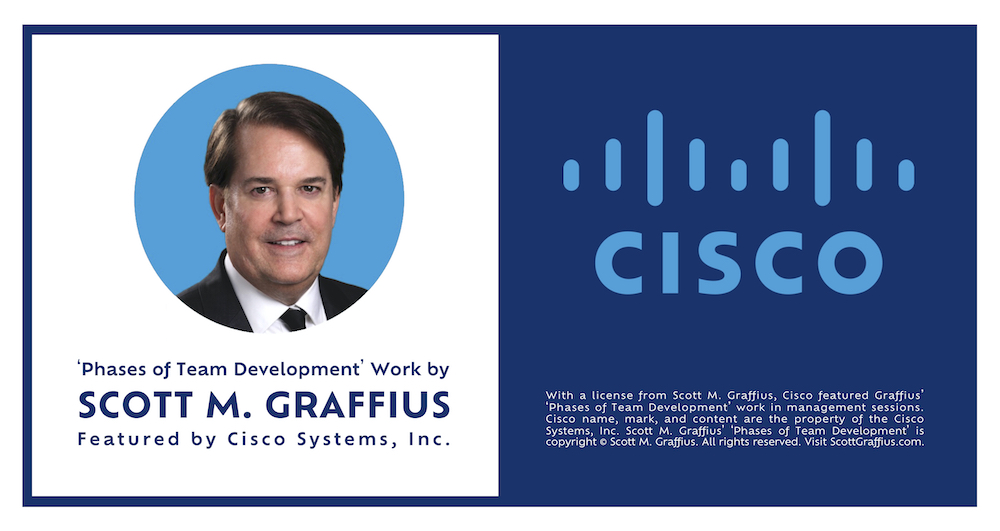














In Technology, there's no substitute for experience. However, certifications remain a valuable tool for advancing one's career.
Since 2017, Scott M. Graffius has researched and reported on the most valuable Information Technology (IT) related certifications. As new technologies emerge and business needs shift, the landscape of in-demand skills evolves. To reflect these ongoing changes, Graffius regularly updates his work. This article presents the 2025 edition of the most valuable IT certifications.


Certifications can help position people as a valuable asset to their current—and prospective future—employers.
Employers want employees and candidates with up-to-date knowledge and skills, and certifications demonstrate one's mastery of the respective subject. Additionally, certifications can advance marketability, leading to promotions and higher pay.
Graffius compiled and analyzed data from 15 sources—including the California Institute of Arts and Technology, CIO, CIO Dive, Computer Science, eWeek, Exceptional Agility, Forbes, Fortune, Global Knowledge, Indeed, ITTA, PC Magazine, Robert Half, Skillsoft, and Workday—to identify which IT certifications are widely seen as the most valuable. Ten certifications stood out as the top choices.
Now, on to this list for 2025!


1. CompTIA A+
- Certification name: CompTIA A+
- Certification name abbreviation: A+
- Governing organization - name: CompTIA
- Governing organization - website: https://www.comptia.org
- Short description of certification: This is generally considered to be a certification for people who want to start careers in the IT industry. To acquire the CompTIA A+ certification, you must pass two separate tests: Core 1 and Core 2. Core 1 (220-1101) covers mobile devices, networking technology, hardware, virtualization, and cloud computing. Core 2 (220-1102) covers operating systems, security, software, and operational procedures.
- Prerequisites (if any) for certification: None
- Certification exam – cost: Total cost for the two exams varies by location and other factors. The average total combined cost is $492
- Certification exam – delivery (in-person or online): in-person or online
- Certification exam – number of questions: Core 1 exam has 90 questions, Core 2 exam also has 90 questions
- Certification exam – time to complete it: 90 minutes for Core 1 exam, and 90 minutes for Core 2 exam
- Certification exam – minimum pass rate (X% or higher correct required to pass exam): Estimated to be 83% for the Core 1 exam. Estimated to be 86% for the Core 2 exam.
- Certification expiration – does it expire? Yes
- Certification expiration – how long does it last before expiring? 3 years
- Certification renewal cost: $75
Note: Prerequisites, cost (shown in United States Dollar - USD), and other data are subject to change by the governing organization.


2. Cisco Certified Network Associate (CCNA)
- Certification name: Cisco Certified Network Associate
- Certification name abbreviation: CCNA
- Governing organization - name: Cisco
- Governing organization - website: https://www.cisco.com
- Short description of certification: Validates the ability to install, operate, configure, and troubleshoot basic Cisco networking devices and technologies.
- Prerequisites (if any) for certification: No prerequisites. However, Cisco recommends having at least a basic knowledge of networking and at least one year of experience with Cisco products.
- Certification exam – cost: $300
- Certification exam – delivery (in-person or online): In-person or online
- Certification exam – number of questions: Varies, between 50-75 questions
- Certification exam – time to complete it: 120 minutes
- Certification exam – minimum pass rate (X% or higher correct required to pass exam): Estimated to be 80%
- Certification expiration – does it expire? Yes
- Certification expiration – how long does it last before expiring? 3 years
- Certification renewal cost: $150
Note: Prerequisites, cost (shown in United States Dollar - USD), and other data are subject to change by the governing organization.


3. Certified Information Systems Security Professional (CISSP)
- Certification name: Certified Information Systems Security Professional
- Certification name abbreviation: CISSP
- Governing organization - name: (ISC)²
- Governing organization - website: https://www.isc2.org
- Short description of certification: The CISSP is a highly respective, vendor-neutral certification that validates a broad understanding of information security and best practices.
- Prerequisites (if any) for certification: At least five years of paid, full time work experience involving two or more (of the eight) domains of the CISSP Common Body of Knowledge (CBK)
- Certification exam - cost: $749, although the cost may vary by location and other factors
- Certification exam - delivery (in-person or online): In-person at a Pearson VUE testing center
- Certification exam - number of questions: Between 125-175 questions
- Certification exam - time to complete it: 4 hours
- Certification exam - minimum pass rate (X% or higher correct required to pass exam): Estimated to be 70%
- Certification expiration - does it expire? Yes
- Certification expiration - how long does it last before expiring? 3 years
- Certification renewal cost: $125
Note: Prerequisites, cost (shown in United States Dollar - USD), and other data are subject to change by the governing organization.


4. Project Management Professional (PMP)
- Certification name: Project Management Professional
- Certification name abbreviation: PMP
- Governing organization - name: Project Management Institute (PMI)
- Governing organization - website: https://www.pmi.org/
- Short description of certification: PMP certification is a globally recognized and sought-after project management credential that recognizes experienced project managers for successfully leading teams through a project’s life cycle.
- Prerequisites (if any) for certification: A or B. (A) Bachelor's degree (or global equivalent) + 36 months of project management experience + 35 hours of project management education/training. Or (B) Secondary degree (high school diploma, associate’s degree or global equivalent) + 60 months of project management experience + 35 hours of project management education/training.
- Certification exam - cost: $405 for members of the PMI, $575 for those not a member of the PMI
- Certification exam - delivery (in-person or online): In-person
- Certification exam - number of questions: Between 180-200 questions
- Certification exam - time to complete it: 230 minutes
- Certification exam - minimum pass rate (X% or higher correct required to pass exam): Estimated to be 81%
- Certification expiration - does it expire? Yes
- Certification expiration - how long does it last before expiring? 3 years
- Certification renewal cost: $150
Note: Prerequisites, cost (shown in United States Dollar - USD), and other data are subject to change by the governing organization.


5. Certified Ethical Hacker (CEH)
- Certification name: Certified Ethical Hacker
- Certification name abbreviation: CEH
- Governing organization - name: EC-Council
- Governing organization - website: https://www.eccouncil.org
- Short description of certification: This certification is obtained by demonstrating knowledge of assessing the security of computer systems by looking for vulnerabilities in target systems, using the same knowledge and tools as a malicious hacker, but in a lawful and legitimate manner to assess the security posture of a target system.
- Prerequisites (if any) for certification: Candidates need to have experience in a job related to network security or complete approved training courses before taking the exam
- Certification exam - cost: $1,199, can vary based on registration options and other factors
- Certification exam - delivery (in-person or online): In-person at a Pearson VUE testing center or online proctored
- Certification exam - number of questions: 125
- Certification exam - time to complete it: 4 hours
- Certification exam - minimum pass rate (X% or higher correct required to pass exam): Estimated to be 70%
- Certification expiration - does it expire? Yes
- Certification expiration - how long does it last before expiring? 3 years
- Certification renewal cost: $85
Note: Prerequisites, cost (shown in United States Dollar - USD), and other data are subject to change by the governing organization.


6. AWS Certified Solutions Architect - Associate (AWS SA)
- Certification name: AWS Certified Solutions Architect - Associate
- Certification name abbreviation: AWS SA
- Governing organization - name: Amazon Web Services (AWS)
- Governing organization - website: http://aws.amazon.com
- Short description of certification: This certification showcases knowledge and skills in AWS technology, across a wide range of AWS services. The focus is on the design of cost- and performance-optimized solutions, demonstrating a strong understanding of the AWS Well-Architected Framework.
- Prerequisites (if any) for certification: None
- Certification exam - cost: $150
- Certification exam - delivery (in-person or online): In-person or online
- Certification exam - number of questions: 65 questions
- Certification exam - time to complete it: 130 minutes
- Certification exam - minimum pass rate (X% or higher correct required to pass exam): Estimated to be 70%
- Certification expiration - does it expire? Yes
- Certification expiration - how long does it last before expiring? 3 years
- Certification renewal cost: $75
Note: Prerequisites, cost (shown in United States Dollar - USD), and other data are subject to change by the governing organization.


7. Azure Administrator Associate
- Certification name: Azure Administrator Associate
- Certification name abbreviation: There isn't an abbreviation designated. AZ-104 (the corresponding exam code for the certification) is sometimes used as an identifier.
- Governing organization - name: Microsoft
- Governing organization - website: https://learn.microsoft.com
- Short description of certification: Azure Administrator Associate (also referred to as Microsoft Certified: Azure Administrator Associate) certification validates one’s ability to manage Azure subscriptions, implement and secure infrastructure, configure virtual networks, deploy virtual machines, monitor resources, and troubleshoot issues.
- Prerequisites (if any) for certification: None, but Microsoft recommends at least six months of experience administering Azure
- Certification exam - cost: $165
- Certification exam - delivery (in-person or online): In-person or online proctored
- Certification exam - number of questions: Varies, typically between 40-60 questions
- Certification exam - time to complete it: 120 minutes
- Certification exam - minimum pass rate (X% or higher correct required to pass exam): Estimated to be 70%
- Certification expiration - does it expire? Yes
- Certification expiration - how long does it last before expiring? 1 year
- Certification renewal cost: Free renewal
Note: Prerequisites, cost (shown in United States Dollar - USD), and other data are subject to change by the governing organization.


8. Google Certified Professional Cloud Architect (GCP Architect)
- Certification name: Google Certified Professional Cloud Architect
- Certification name abbreviation: GCP Architect
- Governing organization - name: Google
- Governing organization - website: https://cloud.google.com
- Short description of certification: Demonstrates expertise in designing, developing, and managing secure, reliable, scalable, and cost-effective solutions on the Google Cloud Platforms (GCP)
- Prerequisites (if any) for certification: None; familiarity with GCP products and services is recommended
- Certification exam - cost: $200
- Certification exam - delivery (in-person or online): In-person
- Certification exam - number of questions: 50 questions
- Certification exam - time to complete it: 120 minutes
- Certification exam - minimum pass rate (X% or higher correct required to pass exam): Estimated to be 70%
- Certification expiration - does it expire? Yes
- Certification expiration - how long does it last before expiring? 2 years
- Certification renewal cost: $100
Note: Prerequisites, cost (shown in United States Dollar - USD), and other data are subject to change by the governing organization.


9. Certified ScrumMaster (CSM)
- Certification name: Certified ScrumMaster
- Certification name abbreviation: CSM
- Governing organization - name: Scrum Alliance
- Governing organization - website: https://www.scrumalliance.org
- Short description of certification: Validates a solid understanding of Scrum including practical ways to apply it on one’s team and organization
- Prerequisites (if any) for certification: Completion of a two-day course by an authorized trainer
- Certification exam - cost: Course (referenced above) includes the cost of the exam. Cost ranges from about $500 to $1,500 depending on the location, delivery format, and other factors
- Certification exam - delivery (in-person or online): Online
- Certification exam - number of questions: 50
- Certification exam - time to complete it: 1 hour
- Certification exam - minimum pass rate (X% or higher correct required to pass exam): Estimated to be 74%
- Certification expiration - does it expire? Yes
- Certification expiration - how long does it last before expiring? 2 years
- Certification renewal cost: $100
Note: Prerequisites, cost (shown in United States Dollar - USD), and other data are subject to change by the governing organization.


10. Certified Artificial Intelligence Scientist (CSAI)
- Certification name: Certified Artificial Intelligence Scientist
- Certification name abbreviation: CAIS
- Governing organization - name: United States Artificial Intelligence Institute (USAII)
- Governing organization - website: https://www.usaii.org
- Short description of certification: The CAIS is publicized by USAII as the most sophisticated and ground-breaking certification program for senior AI professionals and business leaders to develop the perfect AI solutions and strategy, bringing the right organizational change leading to an absolute business transformation.
- Prerequisites (if any) for certification: One of three eligibility paths and completion of a self-paced course. Path 1: Bachelor's degree (or equivalent) in any academic discipline; and at least five years of experience in Artificial Intelligence, Machine Learning, Data Science, Business Analytics, Business Intelligence, Project Management, or any Programming Languages. Path 2: Bachelor's degree (or equivalent) in any academic discipline; and at least four years of experience in Artificial Intelligence, Machine Learning, Data Science, Business Analytics, Business Intelligence, Engineering, Finance, or Management. Path 3: Certified Artificial Intelligence Consultant (CAIC) (or other equivalent) certification; and at least four years of experience for a candidate who has a Bachelor's degree (or equivalent), or three years of experience for a candidate who has a Master's degree (or equivalent).
- Certification exam - cost: Course (referenced above) includes the cost of the exam. Cost is $894.
- Certification exam - delivery (in-person or online): In-person
- Certification exam - number of questions: 80
- Certification exam - time to complete it: 100 minutes
- Certification exam - minimum pass rate (X% or higher correct required to pass exam): 70%
- Certification expiration - does it expire? Yes
- Certification expiration - how long does it last before expiring? 3 years
- Certification renewal cost: $249
Note: Prerequisites, cost (shown in United States Dollar - USD), and other data are subject to change by the governing organization.


Certifications can provide significant value for professionals looking to enhance their skills and credibility in the marketplace. Employers often prefer to hire certified professionals, and people who invest in professional credentials typically enjoy larger salaries.
Informed by data from multiple sources, this article identified and profiled 10 IT-related certifications: CompTIA A+, Cisco Certified Network Associate (CCNA), Certified Information Systems Security Professional (CISSP), Project Management Professional (PMP), Certified Ethical Hacker (CEH), AWS Certified Solutions Architect - Associate (AWS SA), Azure Administrator Associate, Google Certified Professional Cloud Architect (GCP Architect), Certified ScrumMaster (CSM), and Certified Artificial Intelligence Scientist (CAIS).
Those interested in securing one or more IT-related certifications can leverage the data presented in this article to assist in their decision-making.


References/Sources:
- California Institute of Arts and Technology (CIAT) (2024, February). 10 In-Demand IT Jobs You Can Get With Tech Certifications. Available at: https://www.ciat.edu/blog/10-in-demand-it-jobs-you-can-get-with-tech-certifications.
- CIO (2024, November 24). The 15 Most Valuable IT Certifications Today. Available at: https://www.cio.com/article/286762/careers-staffing-12-it-certifications-that-deliver-career-advancement.html.
- CIO.com (2024, June 7). Top 8 IT Certifications in Demand Today. Available at: https://www.cio.com/article/193586/top-15-it-certifications-in-demand-today.html.
- CIO Dive (2023, November 14). 5 Highest-Paying IT Certifications in 2023. Available at: https://www.ciodive.com/news/top-paying-IT-certifications-project-management-security/699641.
- Computer Science(dot)org. (2023, November 9). Best IT Certifications To Boost Your Computer Science Career. Available at: https://www.computerscience.org/resources/top-it-certifications.
- eWeek (2024, February 8). 30 Top AI Certifications: Hotlist of 2024. Available at: https://www.eweek.com/artificial-intelligence/ai-certifications.
- Exceptional Agility (2024, January 4). Top Agile Certifications: Update for 2024. Available at: https://exceptionalagility.com/blog/files/top-agile-certifications-2024.html.
- Forbes (2024, March 21). 10 Certificates To Put On Your Resume In 2024. Available at: https://www.forbes.com/sites/rachelwells/2024/03/21/10-certificates-to-put-on-your-resume-in-2024/.
- Fortune (2023, November 14). How Much Can You Make with IT Certifications? Available at: https://fortune.com/education/articles/how-much-can-you-make-with-it-certifications-average-salaries.
- Global Knowledge (2023, April 27). 10 Top-Paying IT Certifications. Available at: https://www.globalknowledge.com/us-en/resources/resource-library/articles/10-top-paying-it-certifications.
- Graffius, Scott M. (2024, March 15). Most Valuable IT Certifications: Update for 2024. Available at: https://scottgraffius.com/blog/files/it-certs-2024.html. DOI: 10.13140/RG.2.2.11776.03849.
- Indeed (2023, December 18). Top 17 IT Certifications in Demand for 2024. Available at: https://www.indeed.com/career-advice/career-development/top-it-certifications.
- Indeed (2024, April 18). 10 High-Paying IT Certifications. Available at: https://www.indeed.com/career-advice/finding-a-job/highest-paying-it-certifications.
- ITTA (2024, November 7). Top 10 Must-have IT certifications for 2025. Available at: https://www.itta.net/en/blog/top-10-must-have-it-certifications-for-2025/.
- PC Magazine (2023, December 1). Level Up Your Career: The Highest-Paying IT Certifications for 2024. Available at: https://www.pcmag.com/news/highest-paying-it-certifications.
- Robert Half (2023, November 27). The 29 Most Valuable IT Certifications. Available at: https://www.roberthalf.com/us/en/insights/career-development/which-it-certifications-are-most-valuable.
- Robert Half (2024, December 17). 34 of the Best IT Certifications for Boosting Your Tech Career. Available at: https://www.roberthalf.com/us/en/insights/career-development/which-it-certifications-are-most-valuable.
- Skillsoft (2024, January 16). The 20 Top-Paying Microsoft Certifications in 2024. Available at: https://www.skillsoft.com/blog/top-paying-microsoft-certifications.
- Workday (2025, February 4). Ultimate Guide to IT Certifications in 2025. Available at: https://blog.workday.com/en-us/ultimate-guide-to-it-certifications-in-2025.html.


How to Cite This Article
Graffius, Scott M. (2025, February 5). Most Valuable IT Certifications: Update for 2025. Available at: https://scottgraffius.com/blog/files/top-it-certifications-update-for-2025.html.

About Scott M. Graffius

Scott M. Graffius is an AI, Agile, and Project Management/PMO leader, researcher, author, and speaker. Along the way, he spearheaded initiatives that have generated over $2.3 billion in impact for organizations across tech, entertainment, finance, healthcare, and beyond. The following sections provide additional information on his experience, contributions, and influence.
Experience
Graffius heads the professional services firm Exceptional PPM and PMO Solutions, along with its subsidiary Exceptional Agility. These consultancies offer strategic and tactical advisory, training, embedded expertise, and consulting services to the public, private, and government sectors. They help organizations enhance their capabilities and results in agile, project management, program management, portfolio management, and PMO leadership, supporting innovation and driving competitive advantage. The consultancies confidently back services with a Delighted Client Guarantee™.
Graffius is a former VP of project management with a publicly traded provider of diverse consumer products and services over the Internet. Before that, he ran and supervised the delivery of projects and programs in public and private organizations with businesses ranging from e-commerce to advanced technology products and services, retail, manufacturing, entertainment, and more.
He has experience with consumer, business, reseller, government, and international markets.
Award-Winning Author
Graffius has authored three books.
- Agile Scrum: Your Quick Start Guide with Step-by-Step Instructions, his first book, earned 17 awards.
- Agile Transformation: A Brief Story of How an Entertainment Company Developed New Capabilities and Unlocked Business Agility to Thrive in an Era of Rapid Change, his second book, was named one of the best Scrum books of all time by BookAuthority.
- Agile Protocol: The Transformation Ultimatum, his third book and his first work of fiction, was released in April 2025. The book trailer is on YouTube.
International Public Speaker
Organizations worldwide engage Graffius to present on tech (including AI), Agile, project management, program management, portfolio management, and PMO leadership. He crafts and delivers unique and compelling talks and workshops. To date, Graffius has conducted 93 sessions across 25 countries. Select examples of events include Agile Trends Gov, BSides (Newcastle Upon Tyne), Conf42 Quantum Computing, DevDays Europe, DevOps Institute, DevOpsDays (Geneva), Frug’Agile, IEEE, Microsoft, Scottish Summit, Scrum Alliance RSG (Nepal), Techstars, and W Love Games International Video Game Development Conference (Helsinki), and more.
With an average rating of 4.81 (on a scale of 1-5), sessions are highly valued.
The speaker engagement request form is here.
Thought Leadership and Influence
Prominent businesses, professional associations, government agencies, and universities have showcased Graffius and his contributions—spanning his books, talks, workshops, and beyond. Select examples include:
- Adobe,
- American Management Association,
- Amsterdam Public Health Research Institute,
- Bayer,
- BMC Software,
- Boston University,
- Broadcom,
- Cisco,
- Coburg University of Applied Sciences and Arts - Germany,
- Computer Weekly,
- Constructor University - Germany,
- Data Governance Success,
- Deimos Aerospace,
- DevOps Institute,
- Dropbox,
- EU's European Commission,
- Ford Motor Company,
- Gartner,
- GoDaddy,
- Harvard Medical School,
- Hasso Plattner Institute - Germany,
- IEEE,
- Innovation Project Management,
- Johns Hopkins University,
- Journal of Neurosurgery,
- Lam Research (Semiconductors),
- Leadership Worthy,
- Life Sciences Trainers and Educators Network,
- London South Bank University,
- Microsoft,
- NASSCOM,
- National Academy of Sciences,
- New Zealand Government,
- Oracle,
- Pinterest Inc.,
- Project Management Institute,
- Mary Raum (Professor of National Security Affairs, United States Naval War College),
- SANS Institute,
- SBG Neumark - Germany,
- Singapore Institute of Technology,
- Torrens University - Australia,
- TBS Switzerland,
- Tufts University,
- UC San Diego,
- UK Sports Institute,
- University of Galway - Ireland,
- US Department of Energy,
- US National Park Service,
- US Soccer,
- US Tennis Association,
- Verizon,
- Wrike,
- Yale University,
- and many others.
Graffius has played a key role in the Project Management Institute (PMI) in developing professional standards. He was a member of multiple teams that authored, reviewed, and produced:
- Practice Standard for Work Breakdown Structures—Second Edition.
- A Guide to the Project Management Body of Knowledge—Sixth Edition.
- The Standard for Program Management—Fourth Edition.
- The Practice Standard for Project Estimating—Second Edition.
Additional details are here.
He was also a subject matter expert reviewer of content for the PMI’s Congress. Beyond the PMI, Graffius also served as a member of the review team for two of the Scrum Alliance’s Global Scrum Gatherings.
Acclaimed Authority on Teamwork Tradecraft
Graffius is a renowned authority on teamwork tradecraft. Informed by the research of Bruce W. Tuckman and Mary Ann C. Jensen, over 100 subsequent studies, and Graffius' first-hand professional experience with, and analysis of, team leadership and performance, Graffius created his 'Phases of Team Development' as a unique perspective and visual conveying the five phases of team development. First introduced in 2008 and periodically updated, his work provides a diagnostic and strategic guide for navigating team dynamics. It provides actionable insights for leaders across industries to develop high-performance teams. Its adoption by esteemed organizations such as Yale University, IEEE, Cisco, Microsoft, Ford, Oracle, Broadcom, the U.S. National Park Service, and the Journal of Neurosurgery, among others, highlights its utility and value, solidifying its status as an indispensable resource for elevating team performance and driving organizational excellence.
The 2025 edition of Graffius' "Phases of Team Development" intellectual property is here.
Expert on Temporal Dynamics on Social Media Platforms
Graffius is also an authority on temporal dynamics on social media platforms. His 'Lifespan (Half-Life) of Social Media Posts' research—first published in 2018 and updated annually—delivers a precise quantitative analysis of post longevity across digital platforms, utilizing advanced statistical techniques to determine mean half-life with precision. It establishes a solid empirical base, effectively highlighting the ephemeral nature of content within social media ecosystems. Referenced and applied by leading entities such as the Center for Direct Marketing, Fast Company, GoDaddy, Pinterest Inc., and PNAS, among others, his research exemplifies methodological rigor and sustained significance in the field of digital informatics.
The 2025 edition of Graffius "Lifespan (Half-Life) of Social Media Posts" research is here.
Education and Professional Certifications
Graffius has a bachelor’s degree in psychology with a focus in Human Factors. He holds eight professional certifications:
- Certified SAFe 6 Agilist (SA),
- Certified Scrum Professional - ScrumMaster (CSP-SM),
- Certified Scrum Professional - Product Owner (CSP-PO),
- Certified ScrumMaster (CSM),
- Certified Scrum Product Owner (CSPO),
- Project Management Professional (PMP),
- Lean Six Sigma Green Belt (LSSGB), and
- IT Service Management Foundation (ITIL).
He is an active member of the Scrum Alliance, the Project Management Institute (PMI), and the Institute of Electrical and Electronics Engineers (IEEE).
Advancing AI, Agile, and Project/PMO Management
Scott M. Graffius continues to advance the fields of AI, Agile, and Project/PMO Management through his leadership, research, writing, and real-world impact. Businesses and other organizations leverage Graffius’ insights to drive their success.
Thought Leader | Public Speaker | Agile Protocol Book | Agile Scrum Book | Agile Transformation Book | Blog | Photo | X | LinkedIn | Email













Sign up for Miro—it's free!
(Want more features? You can always upgrade to a paid plan.)

Copyright
Copyright © Scott M. Graffius. All rights reserved.
Content on this site—including text, images, videos, and data—may not be used for training or input into any artificial intelligence, machine learning, or automatized learning systems, or published, broadcast, rewritten, or redistributed without the express written permission of Scott M. Graffius.
